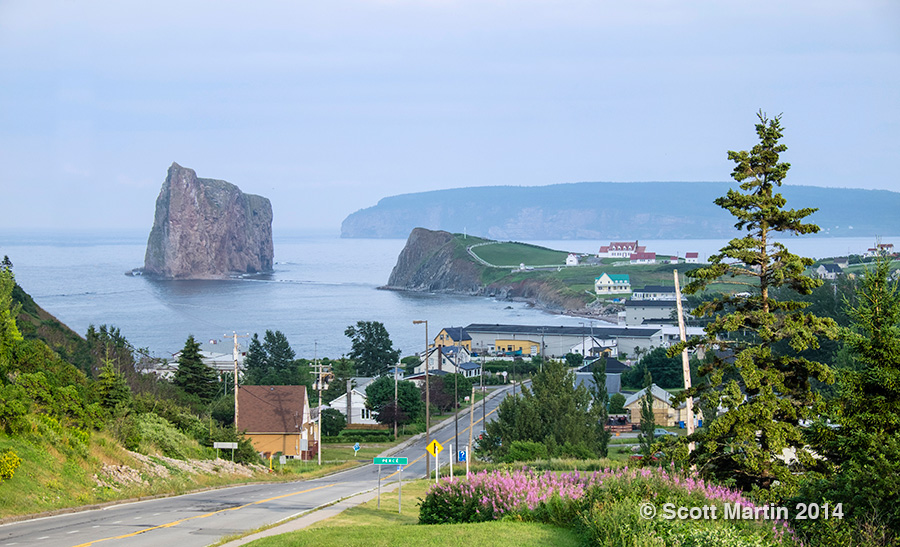
by Scott Martin Photography | Aug 26, 2014 | Blog, Educational, Landscapes, Naturescapes, Travel
As you wind your way around the eastern perimeter of the Gaspé Peninsula in Quebec along Highway 132 you will enter the beautiful little community of Percé, famous for Percé Rock and Bonaventure Island which is home to the second largest Northern Gannet population in the world. The entrance to Percé from the north provides a beautiful vista that is typical of the Gaspé Peninsula. Percé Rock is on the left and Bonaventure Island is in the back ground.

The village of Percé was first settled in the mid nineteenth century and was named after its famous rock which was originally named in 1603 by Samuel de Champlain who called it Pierced Island because of the then two large holes that pierced the rock. Percé is home to about 3,000 people although that number swells in the summer with the influx of tourists.
Percé Rock is made of limestone and measures 1,500′ long, 300′ wide and 300′ high at the highest point. It sits about half a mile from shore and a narrow sand stone bar between the rock and the shore allows one to walk across to the rock during low tide. If fact, when the tide is low it is possible to walk all the way to the fifty foot high hole in the rock. Due to the large amounts of rocks that fall from the rock people are discouraged from walking to the rock, however it is quite a thrill to do so.
Percé Rock is very photogenic and the many different vantage points allow for many great views. Its difficult to get unique images of the rock, however always fun to try. This first image is a simple profile of the rock showing its relation to the town. Originally there were two holes in the rock however the larger of the two collapsed in June 1845 leaving the obelisk that now stands alone at the end of the rock.
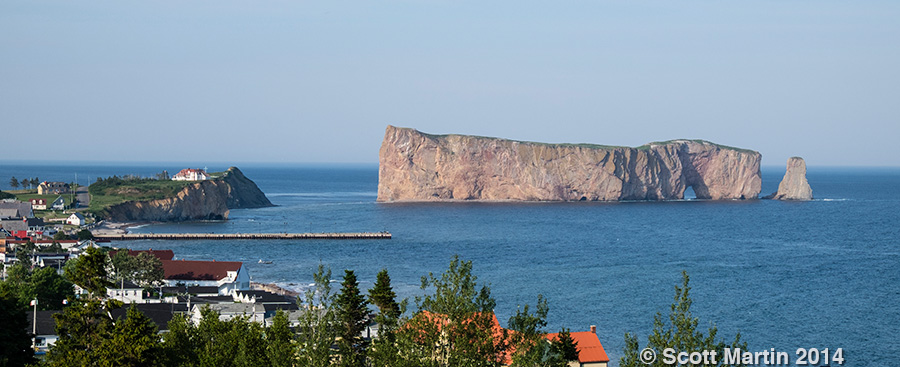
About two miles off shore from Percé is Bonaventure Island, which is a round island of about 1.6 square miles. It is home to the second largest colony of Northern Gannets in the world as well as other pelagic species that nest there in the summer months. It is estimated that there are more than 110,000 Gannets on the Island. You can see Bonaventure Island in this next shot.
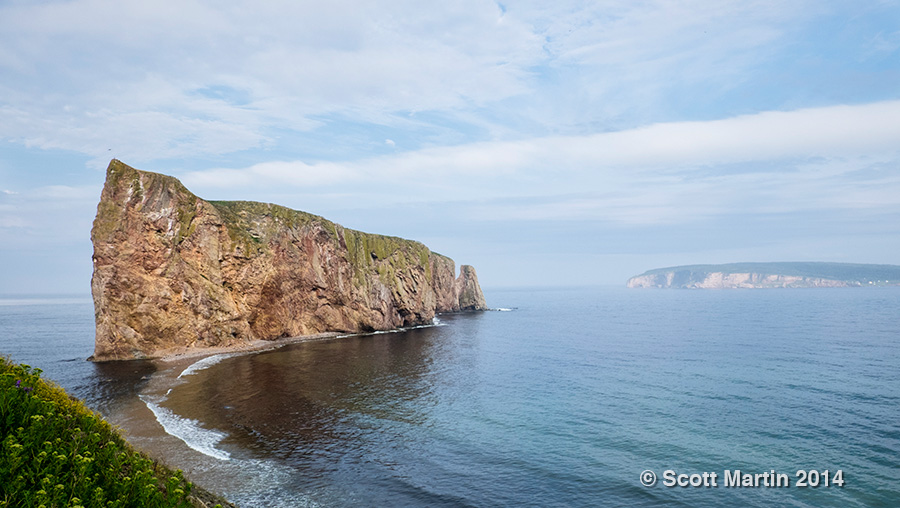
Mount Joli is the distinctively shaped cliff on one end of the sandbar than connects Percé Rock to the mainland (The sandbar is easily seen in the above image). Mount Joli provides a perfect belvedere for photographing Percé Rock….so much so that you now have to pay $2.00 to take the path to a small wooden platform from where you can get that iconic view of the rock. The previous shot and the next few pictures were taken from Mount Joli.
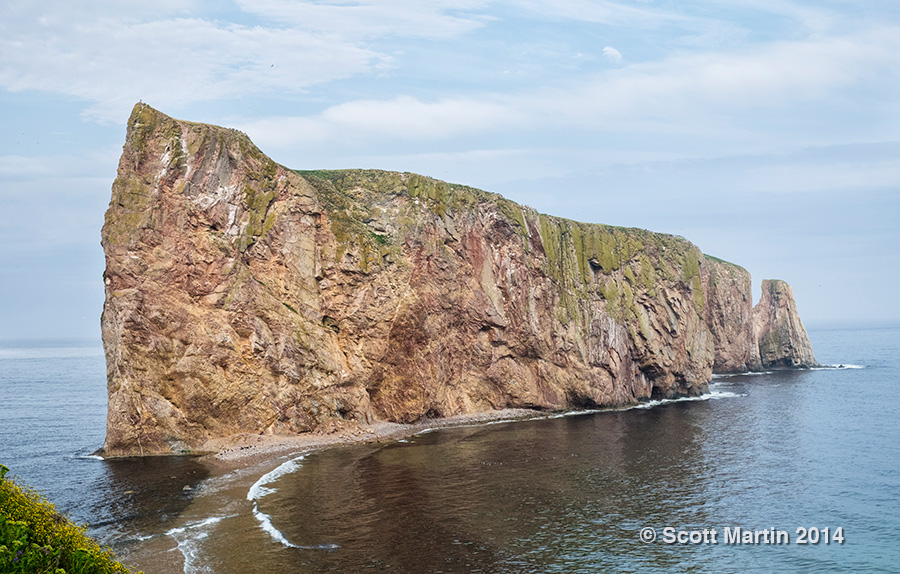
When given the opportunity to include something of interest in the fore ground of an image, it is generally a good idea to do so. The question is to know just how much to include as you don’t want the fore ground inclusion to compete with the object of the image. This next image may have too much however I really like the result and thats the great thing with photography…its a purely subjective art.
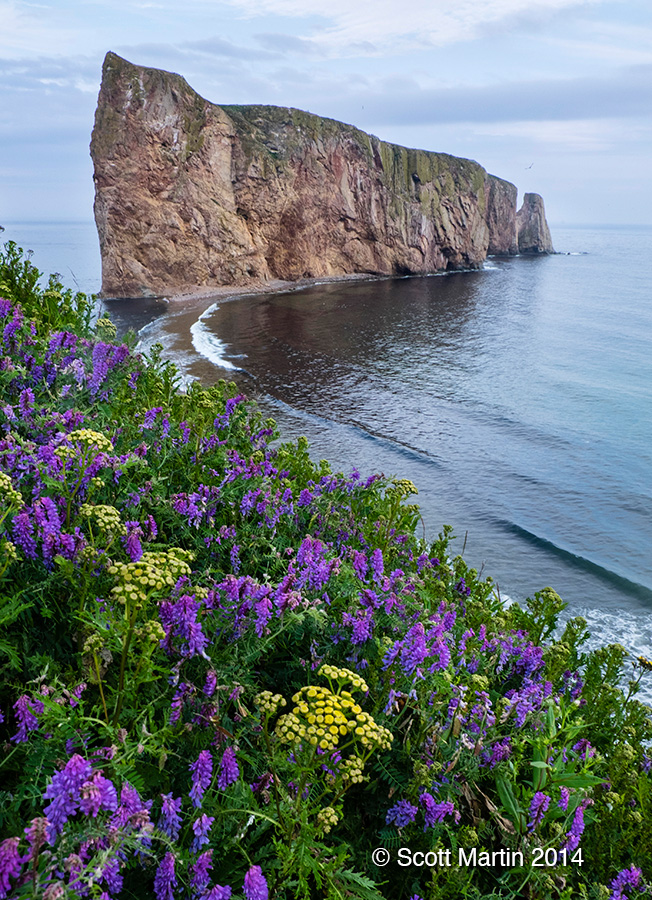
The Gaspé Peninsula has a Roman Catholic religious heritage and churches and crosses are commonplace throughout the region. An old white cross is found on Mount Joli and it was fortunate to have a gull fly by at the perfect time to make an interesting addition to the image.
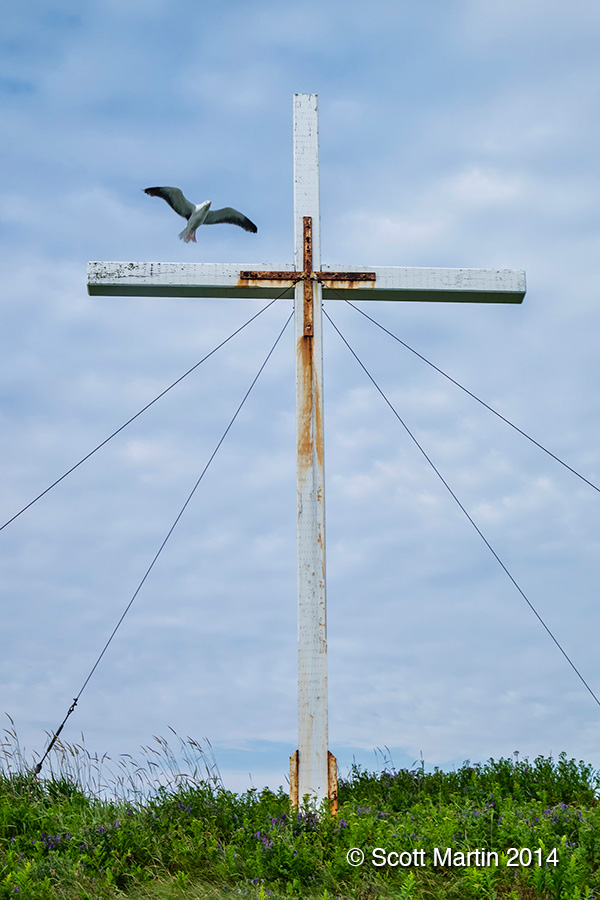
We arrived in Percé late in the afternoon and after checking into our hotel we took the concierge’s recommendation for a good spot to eat. The place he recommended turned out to have completely forgettable food although it did provide a view of the rock that has become one of my favourite images of the trip…always take the camera with you when you go out for diner 🙂
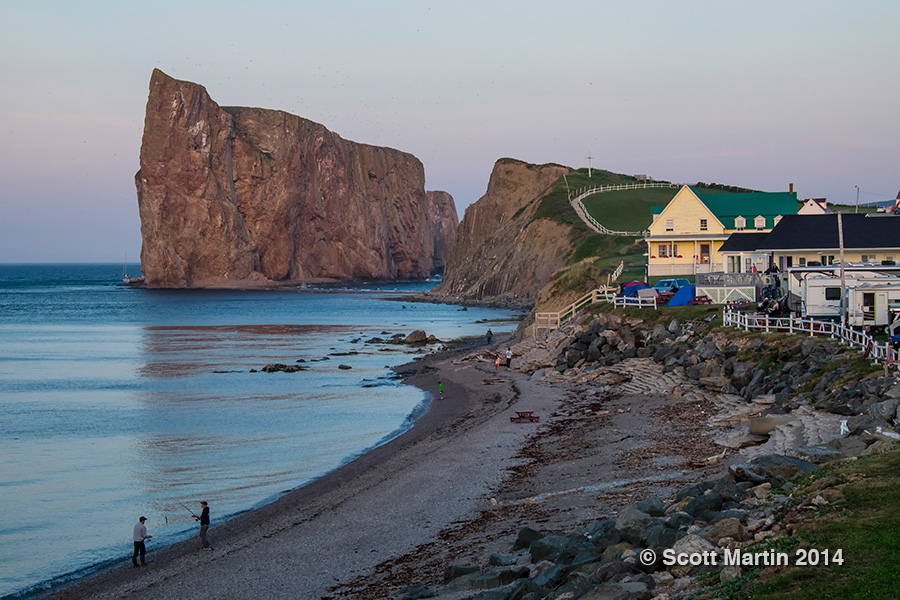
As mentioned, unique shots of iconic objects are difficult to find. Here are a few atypical but probably not unique images of Percé Rock.
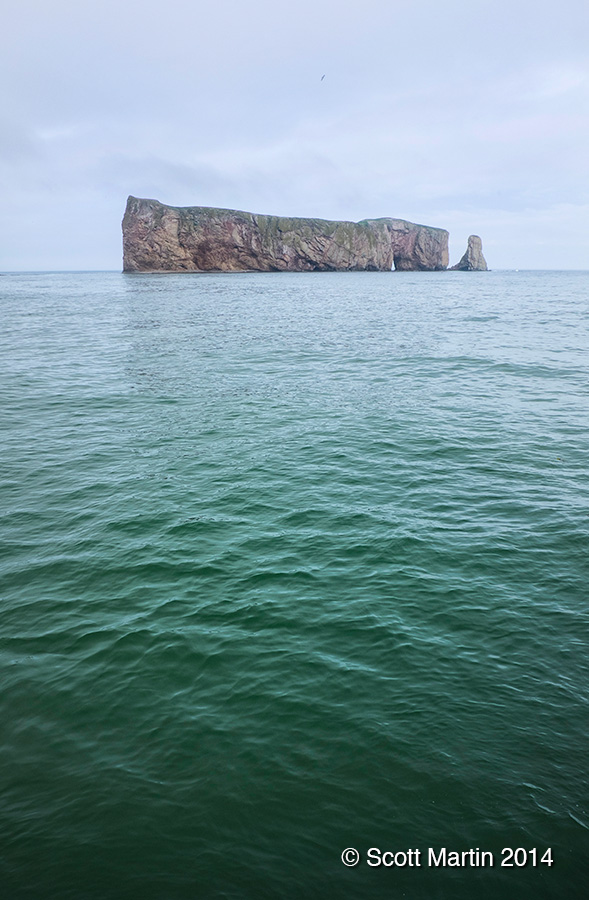
.
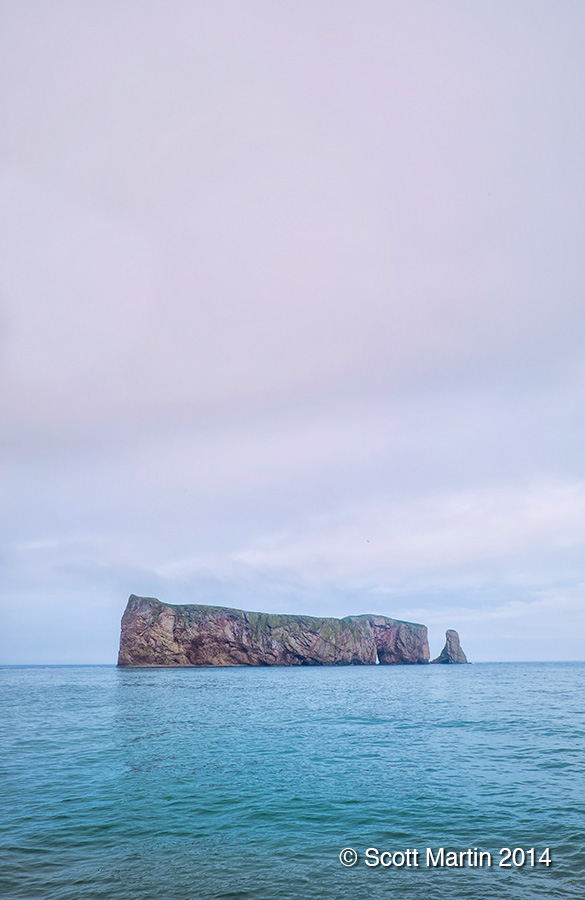
.
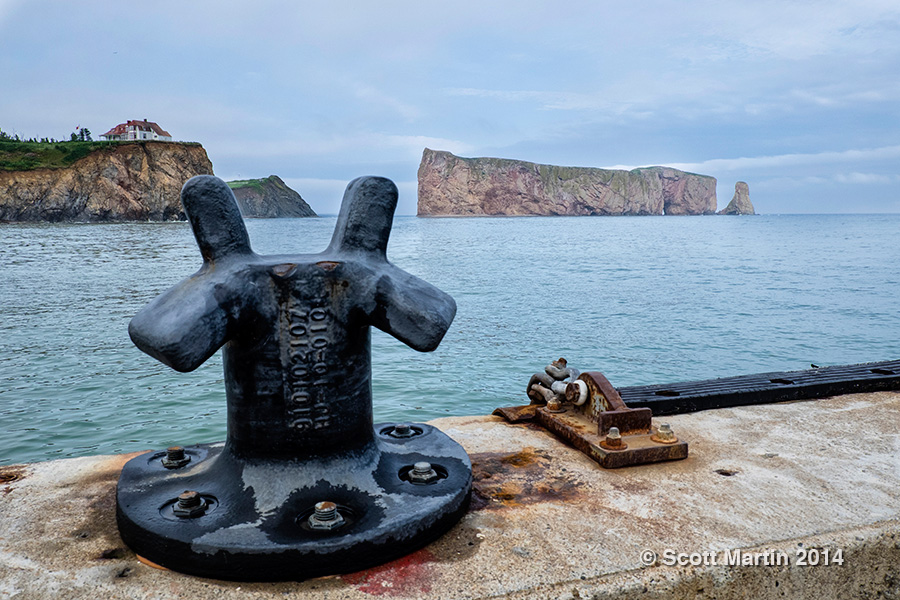
.
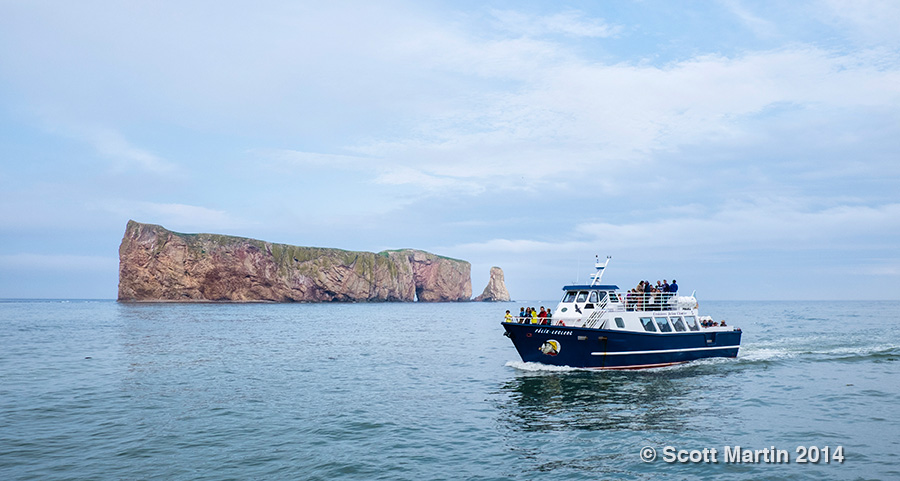
While in Percé we stayed at the Hotel Le Mirage and I would highly recommend that you stay there if you are in the area. Everything was great with our stay at the hotel, especially the view from our second story balcony, from where the next image was taken.

….and the same shot taken a few hours later.
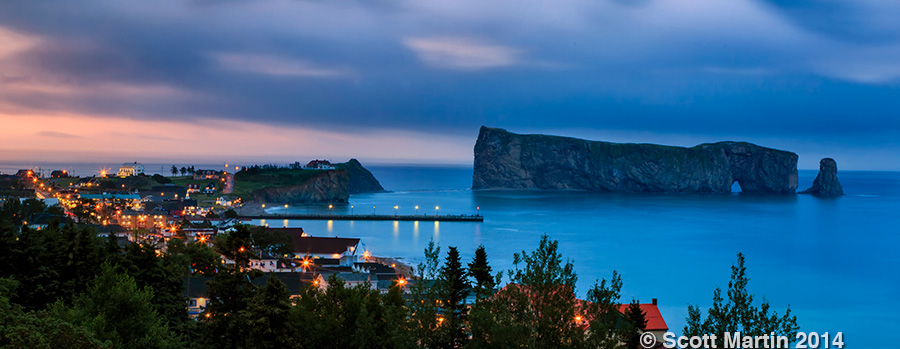
Night photography is a very enjoyable niche that is really quite simple as long as you have a good tripod to keep the camera completely motionless over the long time exposures that are required. It is especially enjoyable when you can practice night photography from the comfort of your hotel room balcony as with these next images. Perhaps because of its location at the tip of a peninsula, the weather conditions are constantly changing around Percé. The winds and clouds are quickly changing and the scenes are rapidly unfolding in front of the camera. The next images were all taken over a period of about an hour.
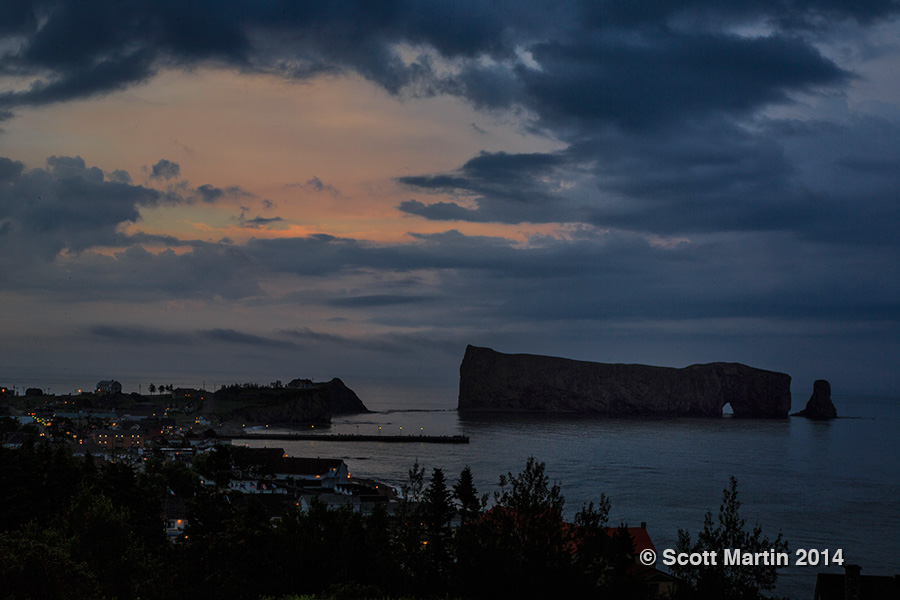
.
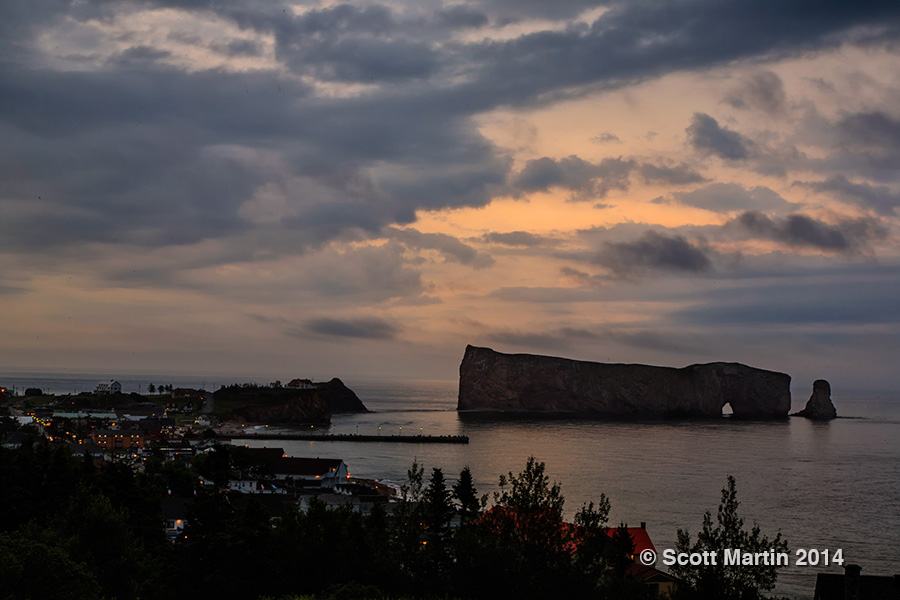
The previous two images are shorter exposures as the cloud detail was very important to the image and therefore any motion in the clouded had to be minimized in order keep the clouds in sharp focus. The next two images have much longer exposures to allow movement in the clouds which blurs them in the image creating a very different feel.
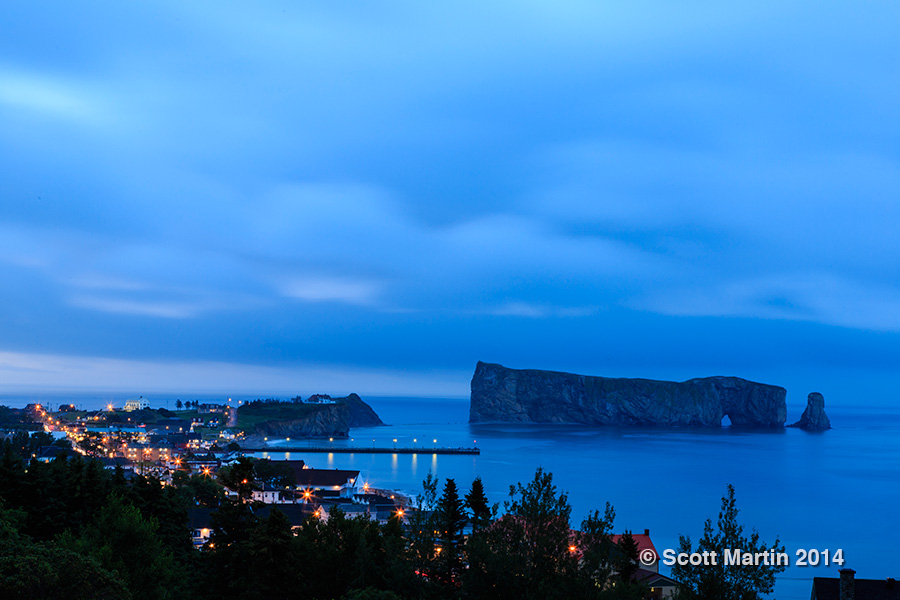
The approaching storm!
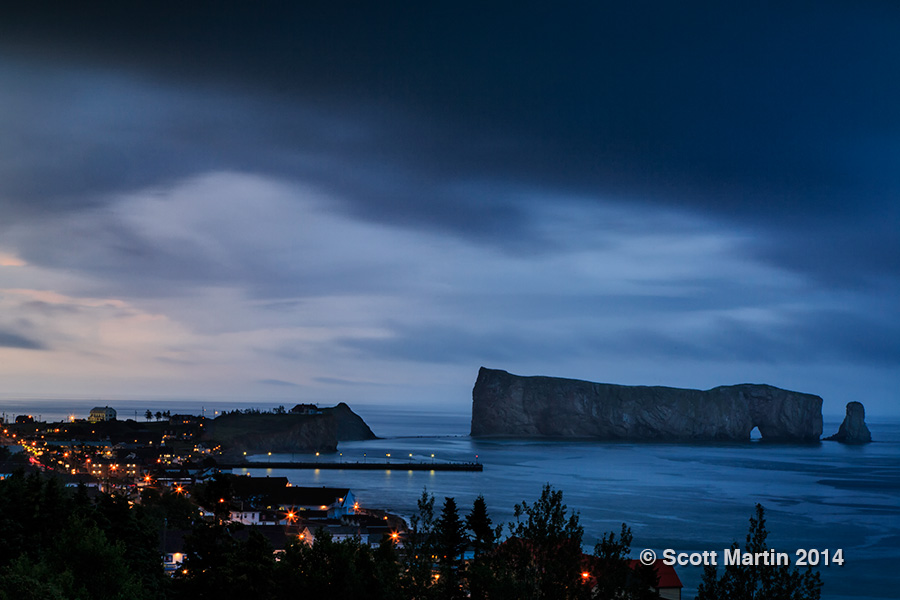
I trust the images in this post have given you a glimpse of what the little village of Percé with its iconic rock is like and I hope that its enough of a glimpse to influence your future travel plans as a personal visit to the area would never disappoint. Its a spectacular and unique corner of our great country that really needs to be seen in person. Even the best photographs can not do the area justice.
With the exception of the night images, which were taken with the Canon 5D and 16-35mm lens, all of the images in this post were taken with the Fuji X-E2 and 18-55mm lens.
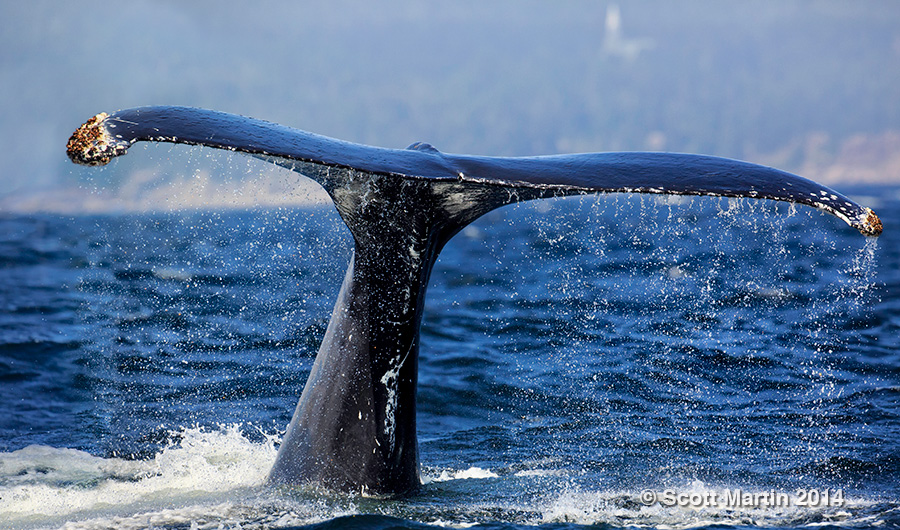
by Scott Martin Photography | Aug 19, 2014 | Blog, Educational, Landscapes, Naturescapes, Travel, Wildlife
We recently returned from an almost 4,000 km drive around the Gaspe Peninsula of Quebec. It was a wonderful trip for many reasons, including that my parents joined us and we were able to visit my Dad’s parents homestead in the little town of New Richmond on the south side of the peninsula. Prior to my grandparents moving to Oshawa in the 1920’s, there were five generations of Martin’s in the Black Cape/New Richmond area of the Gaspe Peninsula.
Undoubtably, one of the high points of the vacation was seeing Minke and Humpback Whales while whale watching out in the rough waters of Gaspe Bay and the Gulf of St. Lawrence. Our boat, the Narval III was operated by Croisieres Baie de Gaspe leaving from Grande-Grave harbour within Forillon National Park, Quebec’s first National park, located at the Eastern tip of the Gaspe Peninsula.
As you can see the Narval III is a beautiful boat for whale watching.
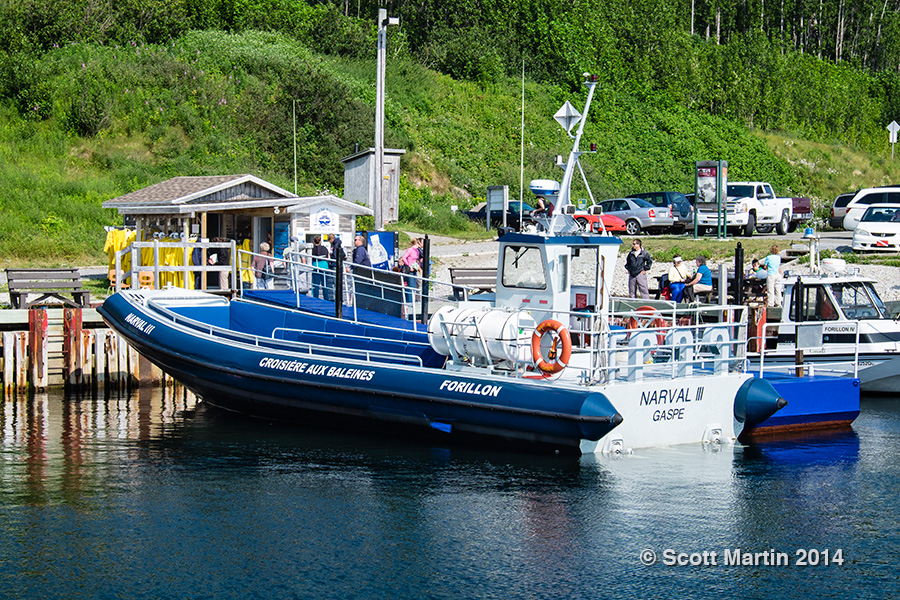
Narval III
This next shot with the smaller red zodiac on the left gives some perspective as to the size of the Narval III.
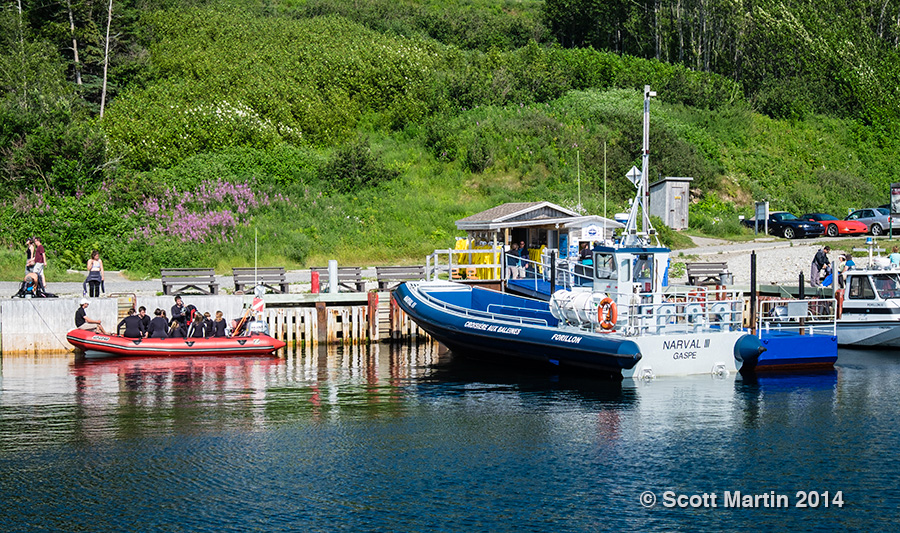
Narval III
We had reserved our spots on the boat a number of weeks before arriving, however because of the rough seas and high winds, we were forewarned that it would be a rough almost three hours on the boat and that we would get completely soaked. Deb & my mom were wise in their decision to stay on shore, but my Dad and I donned the complementary rain gear and climbed aboard. Not knowing anything about whale observation and given the rough seas, I was pretty much convinced we wouldn’t see any whales, however only a few minutes into the voyage we saw some Minke whales, which are the second smallest of the baleen whales (more on baleen whales in a minute). The average length of a Minke whale is 23 feet. It was such a thrill to see even a ‘small’ whale that the trip was already a success, but only a short while later we found a pair of Humpback Whales and I was amazed at how close they would come to the boat as we watched and followed them for the next hour or so.
Here is one of the first pictures I was able to capture of the Humpback Whale.

It is difficult, if not impossible, to describe effectively enough to provide someone else an appreciation for the sheer size of these whales. Humpbacks weigh in at about 40 tons (80,000 pounds) and can reach lengths of 62′, or larger than a transport truck, yet they are very graceful to observe in the water. The normal method of spotting whales is to look for the 10-15′ high water spout created when the whale surfaces to breath and forcibly exhales air through the blowhole before inhaling. This is an easy thing to spot under calm seas, but the high winds and ten foot swells made it much more difficult for us to observe the water spouts. After seeing a spout, the small dorsal fin would appear about twenty feet behind often followed by the fluke or tail, allowing for great photo opportunities. The following are a few of the results.
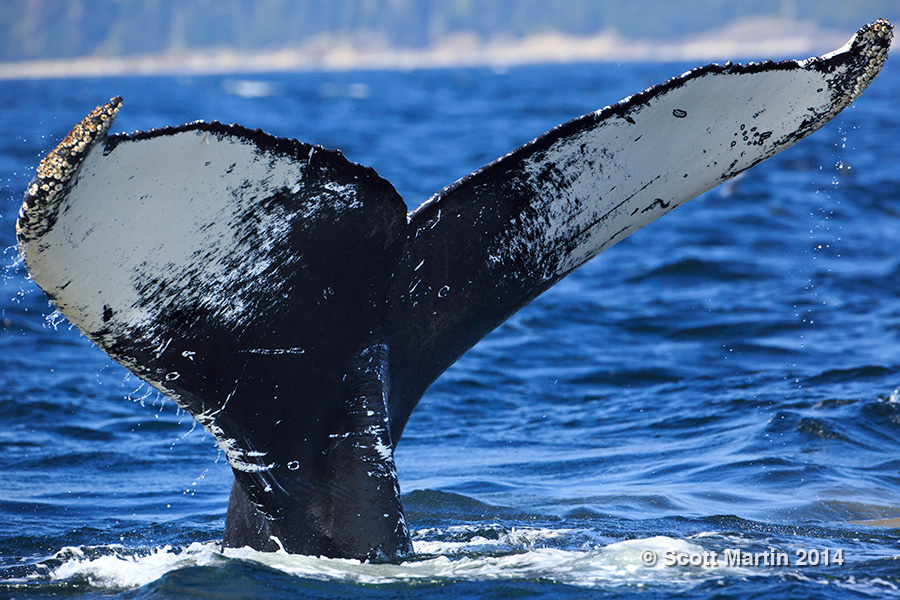
The underside of a Humpback tail has large white areas which are an identification distinction visible from quite far away.
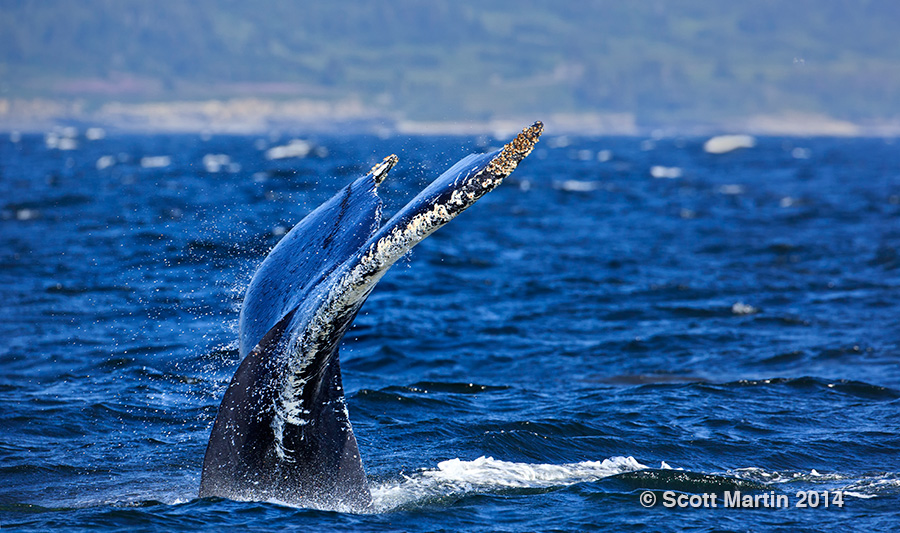
Humpback Whales are part of the baleen whale grouping. Baleen whales are edentulous, meaning they have no teeth, but instead have up to 400 baleen plates on both sides of their mouths. These plates are side by side, perpendicular to the roof of the mouth and can be up to 4′ in length. When the whale closes its mouth while feeding on a school of krill, the small fish are trapped between the baleen plates while the water is expelled. The food is then swallowed. Blue whales, the largest animals on the planet, are also baleen whales, thus the biggest whales in the world have no teeth, which is perhaps one of those little pieces of trivia you will never forget after reading this blog post!
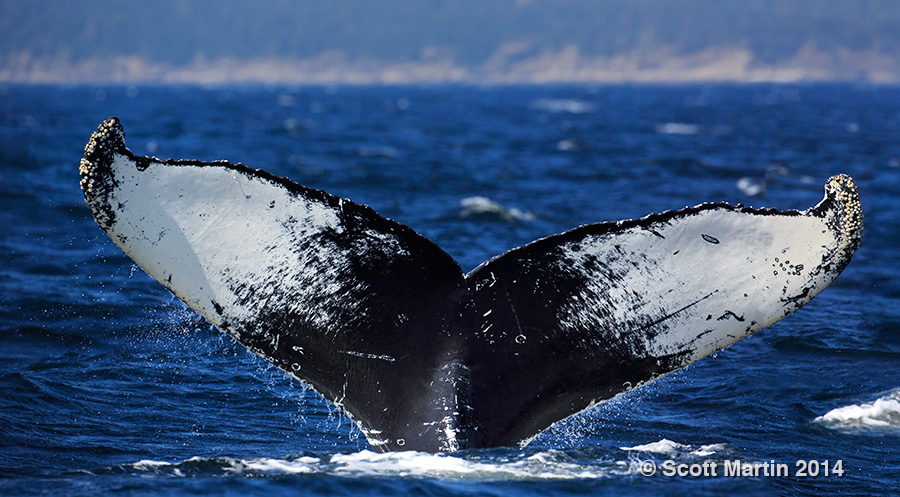
The Humpback Whale, like many whale species, was brought to the brink of extinction around the turn of the last century by over fishing and a hunting ban was implemented in 1966. Since then the population of the Humpback globally has slowly increased, however the National Geographic Association still lists the Humpback as endangered. It is estimated that there are 80,000 Humpbacks alive today.
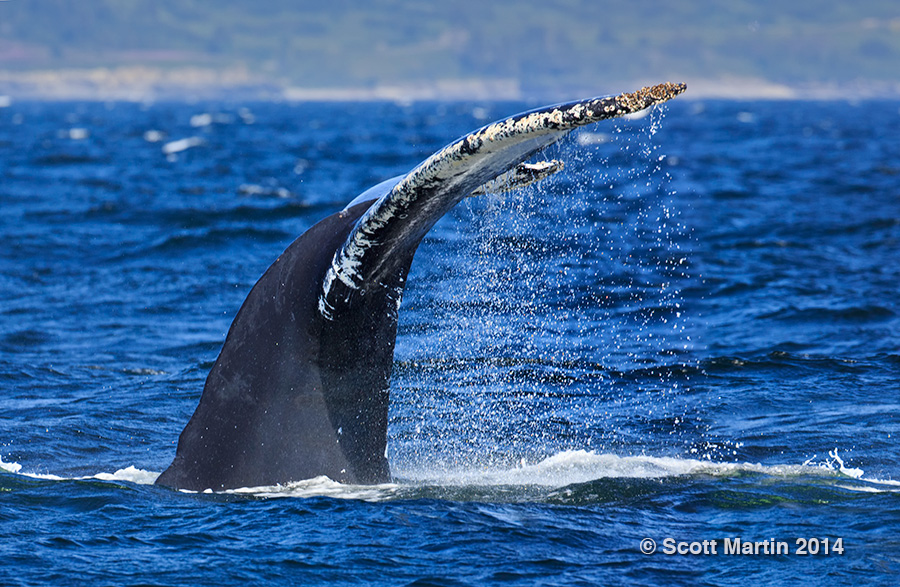
The Humpback Whale gets its name from the distinctive hump seen in its dorsal spine as it arches above the water when it surfaces to breath.
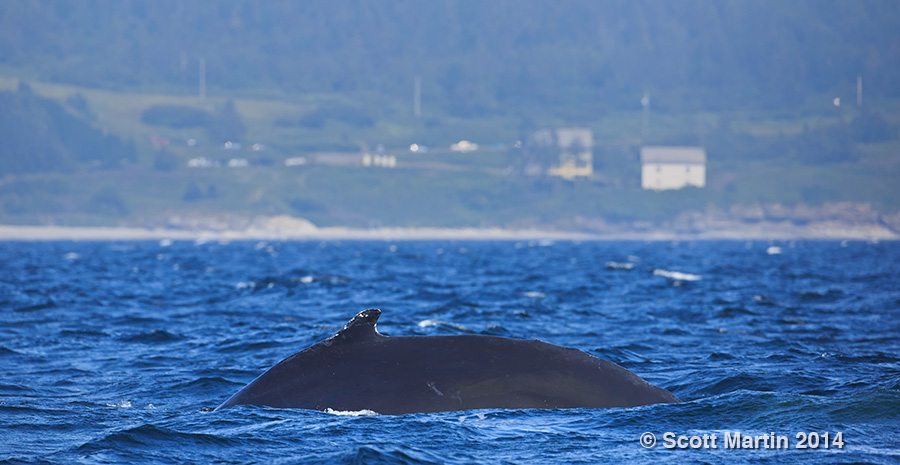
Humpback’s Hump
I was fortunate to capture a unique perspective of the dorsal spine of the Humpback Whale as it surfaced while swimming directly towards the boat. Only a small part of the whale is visible, but you can see how the humpback got its name.
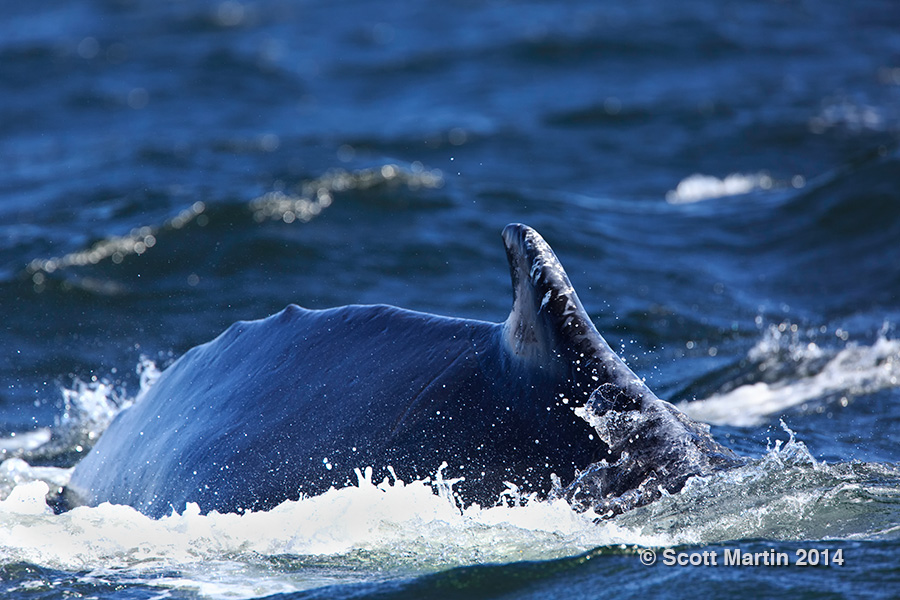
Humpback Whales are migratory animals that cover a lot of miles every year, in fact 16,000 miles on average. They summer in the cooler northern polar waters and head south in the winter to the tropical waters where they breed and give birth to their young. Interestingly they don’t eat while in the cooler waters in the summer and live of the fat reserves created by all the krill and small fish they consume in the winter months. Although they don’t eat in the summer, they continue to produce waste as this next image shows 🙂
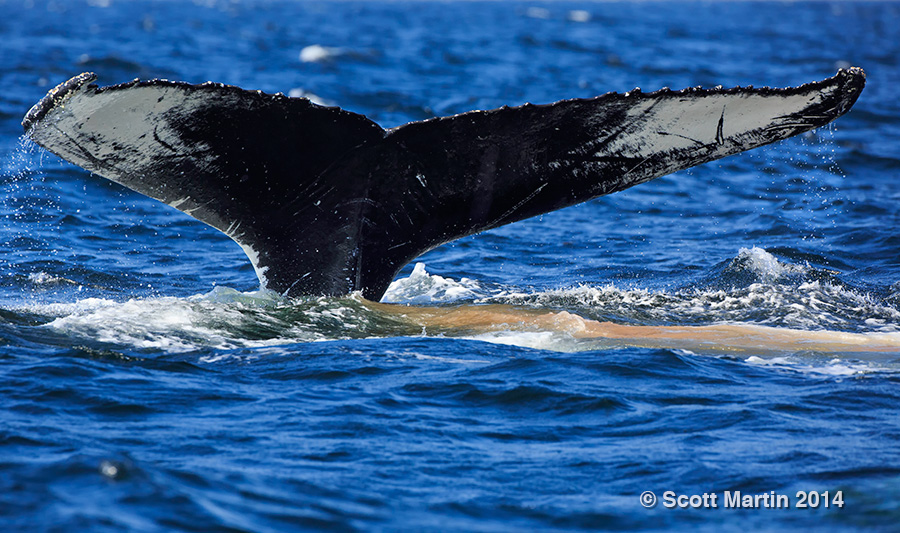
You won’t find this next pic in the gallery, but it is included here in an attempt to convey the relative size of an adult Humpback whale, using the rough waters of Gaspe Bay and the shoreline in the back ground to provide some scale. The width of the Humpback fluke can be up to one third of its length meaning the tail width can reach 15-20 feet or the length of most recreational motor boats.
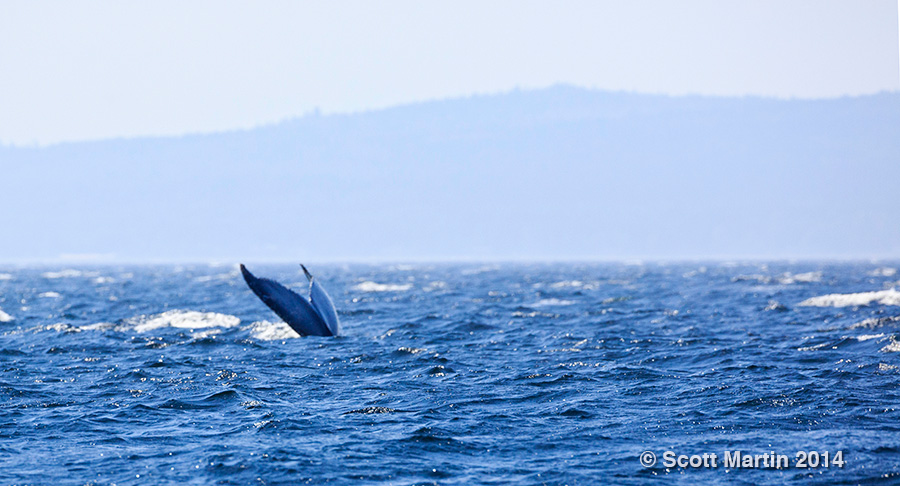
Humpback Fluke
I trust that you have enjoyed these Humpback Whale images and if you’ve never been whale watching, I would urge you to plan a trip to Forillon National Park and sign up for an excursion with Croisieres Baie de Gaspe. You will be amazed when you see up close one of the largest animals that God designed to roam our oceans.
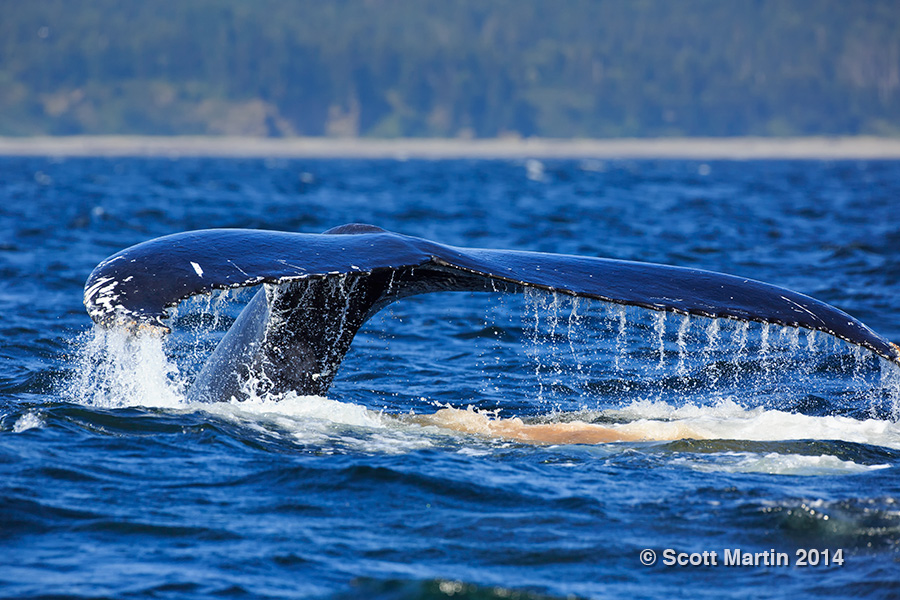
To see the above images in more detail, you can view them in the Wildlife Gallery.
As mentioned in the opening of this blog post, our whale watching excursion left from Grande-Grave Harbour in Forillon National Park. You could easily spend a few days exploring the park itself and admiring its many beautiful vistas overlooking the Gulf of St. Lawrence and Gaspe Bay. One of the most picturesque is Cape Bon Ami in the northern section of the park. The cliffs around the Cape provide nesting grounds for Black-legged Kittiwakes, Razor-billed Auks, Common Murre and Black Guillemots, which will be described in a future post. In the mean time here are some pictures of Cape Bon Ami and the surrounding area.
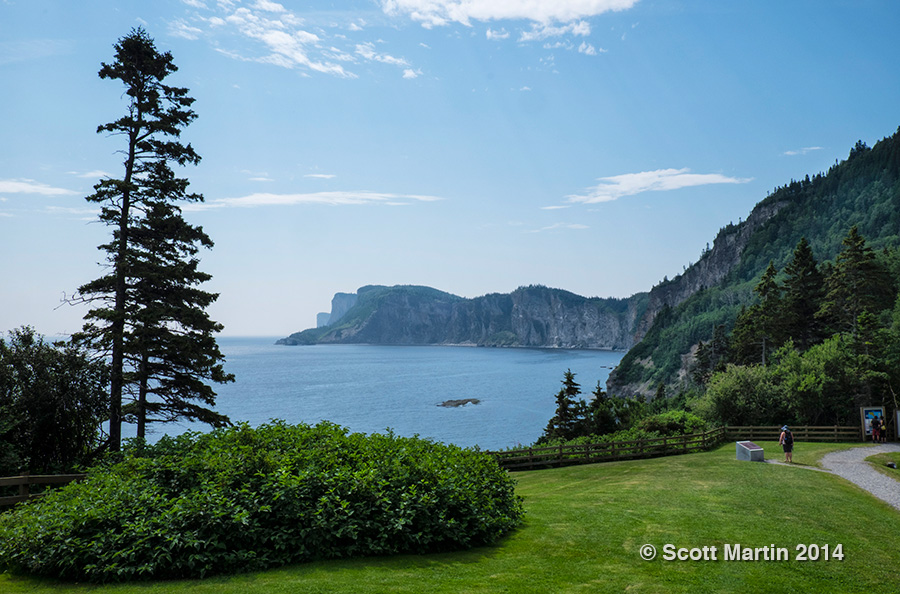
.
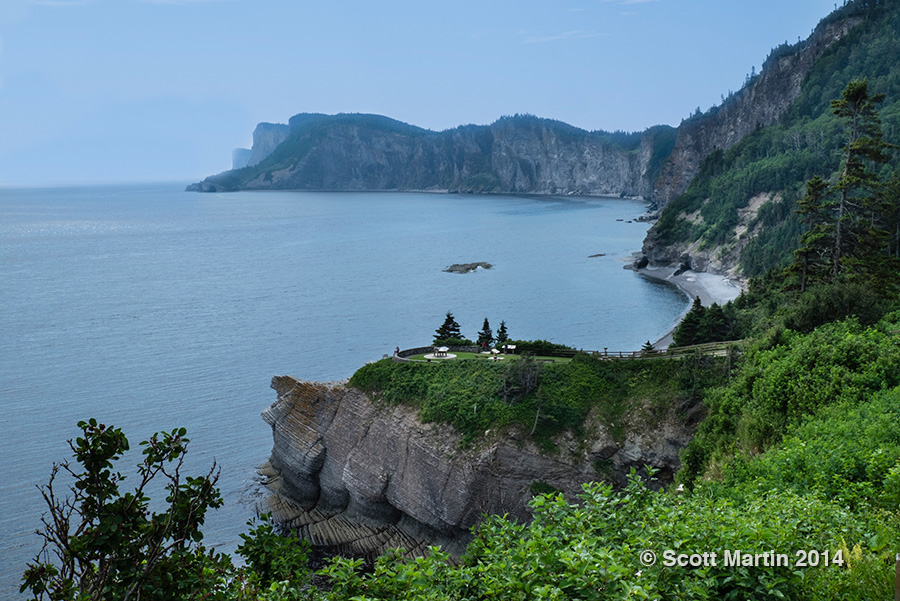
.
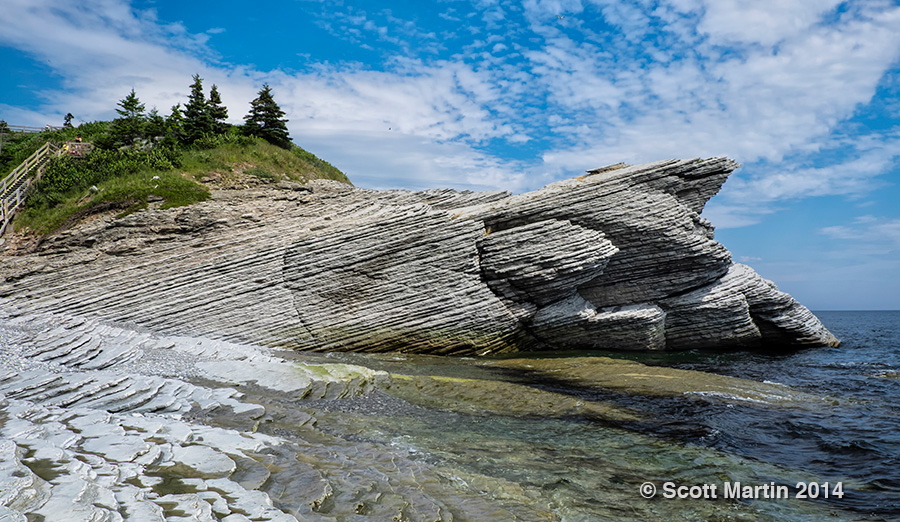
.
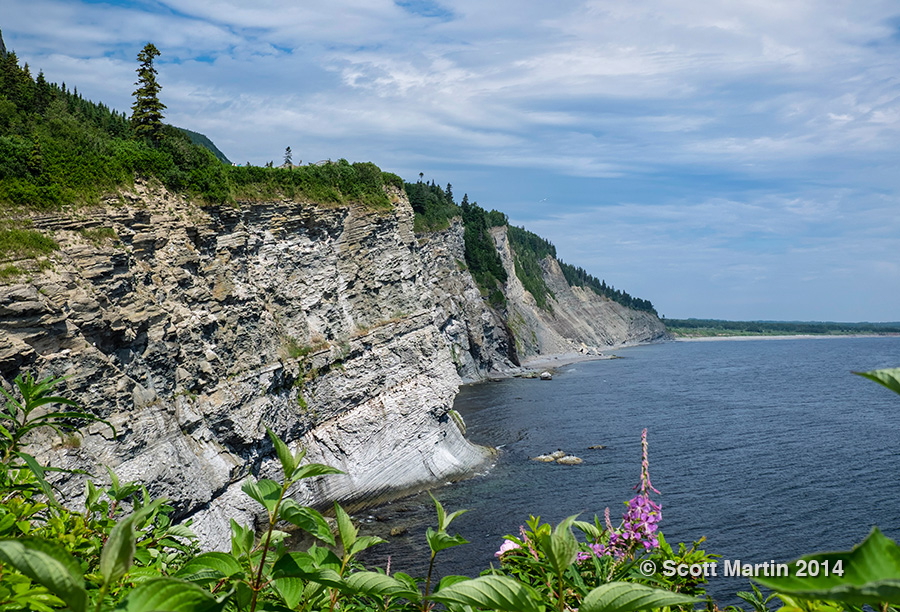
A number of other images from Forillon can be found in the Naturescapes Gallery.
The whale images in this post were all taken with a Canon 5D Mk III and 500 f/4 L lens while all other images were taken with a Fujifilm X-E2 and 18-55 zoom lens. Long time readers of this blog will recognize that this is a significant departure from a gear perspective, however I will talk about the new Fuji equipment in more detail in a future post.
One final note; if you would like to receive future blog posts via email, please enter your email address in the “Subscribe to Blog Via Email” box at the top of the right sidebar. By doing so, you will receive future blog posts via email as soon as they are published. Your email addresses will never be shared and your email subscription is easily managed.
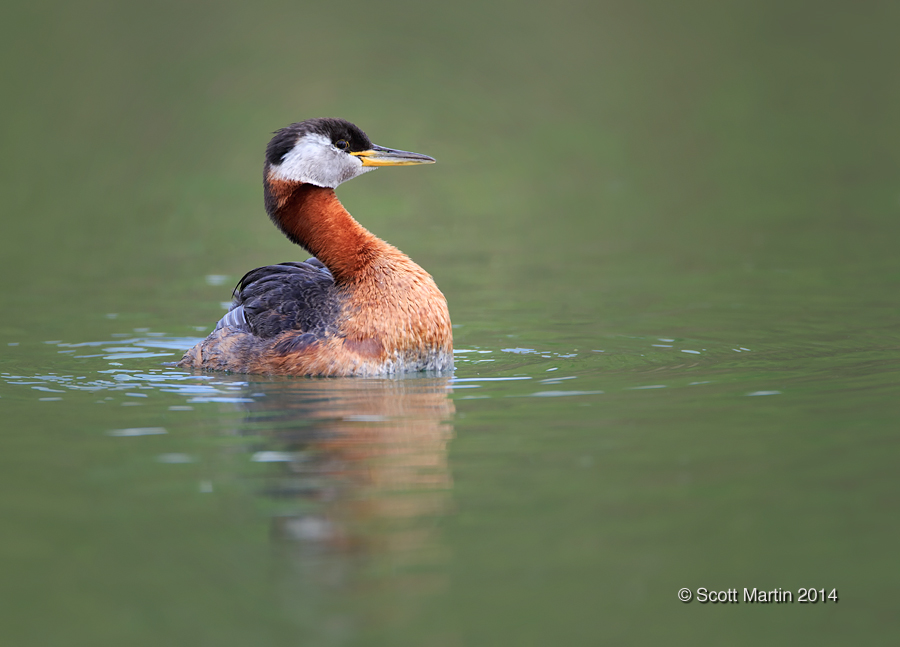
by Scott Martin Photography | Jul 14, 2014 | Birds, Blog, Loons, Shore Birds & Waterfowl, Wildlife
In North America there are seven species of Grebes, however this post will focus on the Red-necked Grebe, which is a medium to large sized bird that frequents fresh water marshes and lakes from the north-west (Alaska & the Yukon) extending southwards to Texas. It is rarely found east of Ontario.
The Red-necked Grebe is a rather nondescript grey bird during the winter months, however transforms into the beautiful bird in this post when it adopts its breeding plumage, including its red neck, white face and black crown with its characteristic tufts.

Grebes typically nest on floating beds of vegetation which allows for protection from the usual land based predators. Like Loons, Grebes are awkward taking flight and ‘run’ along the water for a long distance before acquiring the speed required to take flight. As a result of this you don’t often see Red-necked Grebes in flight other than during migration. Also similar to the Loon, the Grebe’s legs are positioned far back on its body making it very immobile on land but adept in the water. The Grebe dives when faced with a threat as opposed to taking flight. This next image show an adult on the floating nest (in breeding plumage both sexes appear the same so differentiation is very difficult, although the male is usually the heavier of the two sexes).
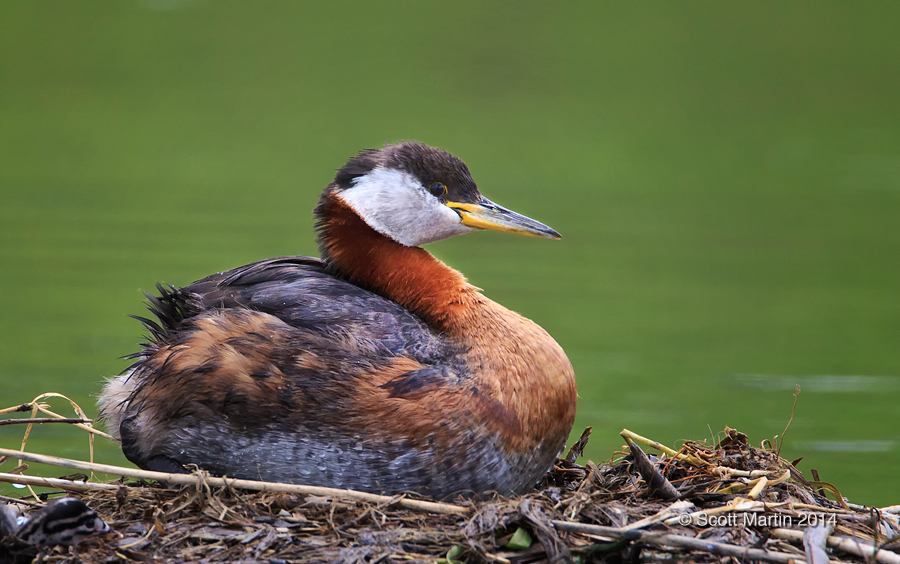
Red-necked Grebes lay two to six eggs which enjoy shared incubation for 20-23 days before hatching. This family had four young ones making for a busy time of feeding. The biggest threat to the young chicks are fish (particularly pike and muskie) and snapping turtles and for this reason, along with the desire to keep warm and comfortable, they spend the first few days of life snuggling on the backs of the parents. It is always a treat to see these young families and watch the young jostle with each other to get the favoured position on mom or dad’s back.

The choice position cuddled at the base of a parent’s neck is only available to one, but perhaps they take turns! Young birds grow very rapidly and Grebes are no exception, so the opportunity to see them on the backs of the parents only lasts for a few days. In just a few months they must be big enough and strong enough to migrate south for the winter. Interestingly, Grebes migrate mostly at night.
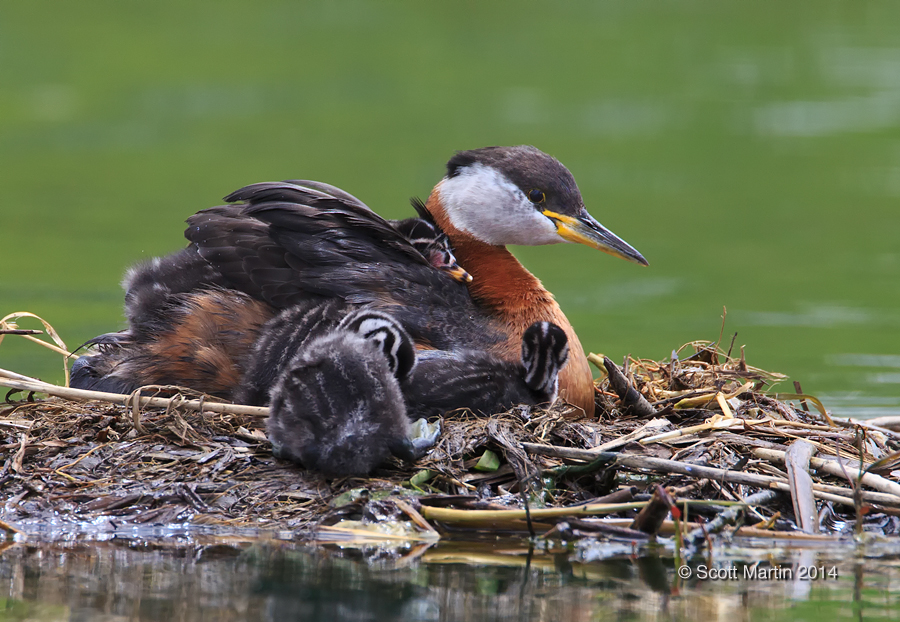
The little sentinel, learning to be a keen observer of the surroundings. Observational skill is essential for survival and although the Grebe reduces land based predator threats by nesting on the water, other birds (hawks and gulls) pose danger as do many other aquatic adversaries (fish, snakes & turtles). Grebes are typically very quiet however when threatened do make a series of loud and unusual screeches & squawks.
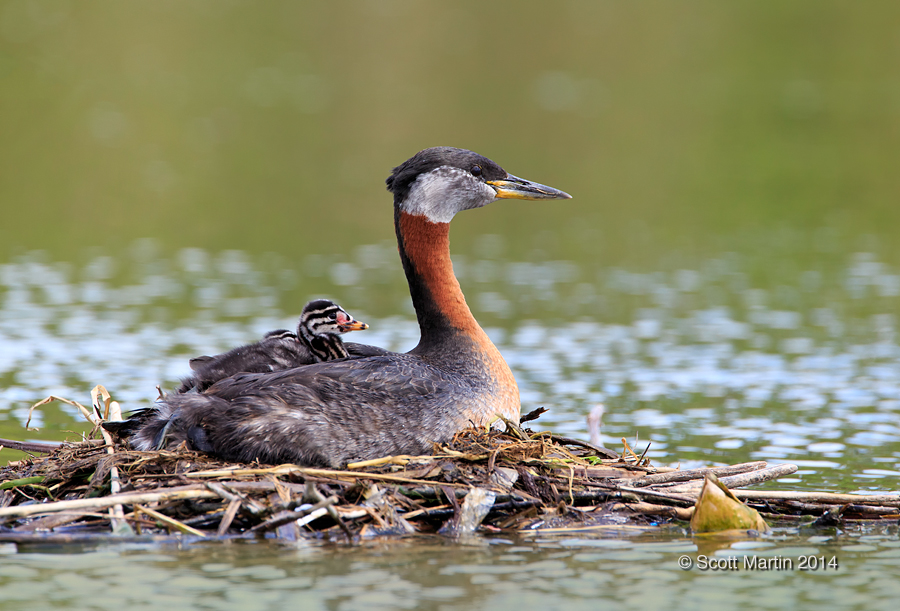
The chicks have very distinctive black and white banding patterns on their head and necks which give them a little zebra like appearance. This next shot captures the unique beauty of the young birds head.
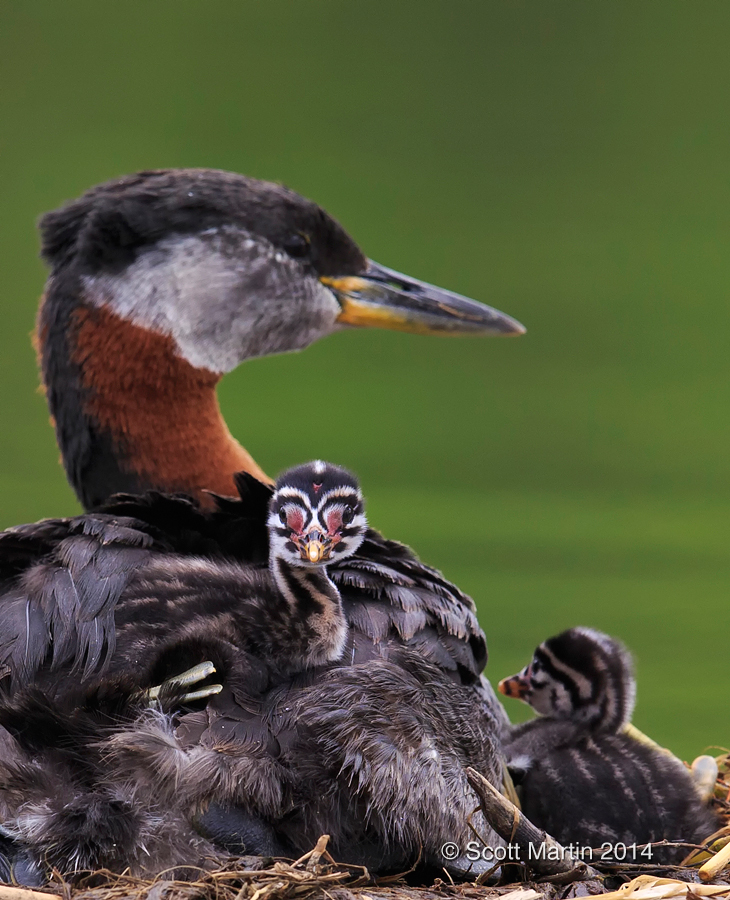
Red-necked Grebes consume mostly invertebrates including insects, molluscs, dragonflies, beetles and crayfish and they also eat fish. The Grebes also have a very peculiar item on their menu; they regularly eat their own feathers and in fact start feeding feathers to the young when they are only a few days old. The feathers remain in the stomach and tend to partially decompose into a soft amorphous mass. It is not known what the purpose of the feathers in the stomach is, although it has been suggested that they form a filter of sorts to prevent ingested bones from damaging the digestive tract.
While my good friend Arni and I were photographing the Grebes pictured in this post, we had the privilege of watching the young chicks being fed numerous times. The challenge was to get a great feeding shot with everybody looking at the approaching meal. Fortunately all four of the young cooperated at least for the split second required to get this shot. This shot is also humorous in that Dad is being overly optimistic in just how big of a fish the young ones could handle and the weight of this meal caused it to be dropped as soon as it was handed over. No problem though as the parent immediately returned with a smaller fry for the youngsters.
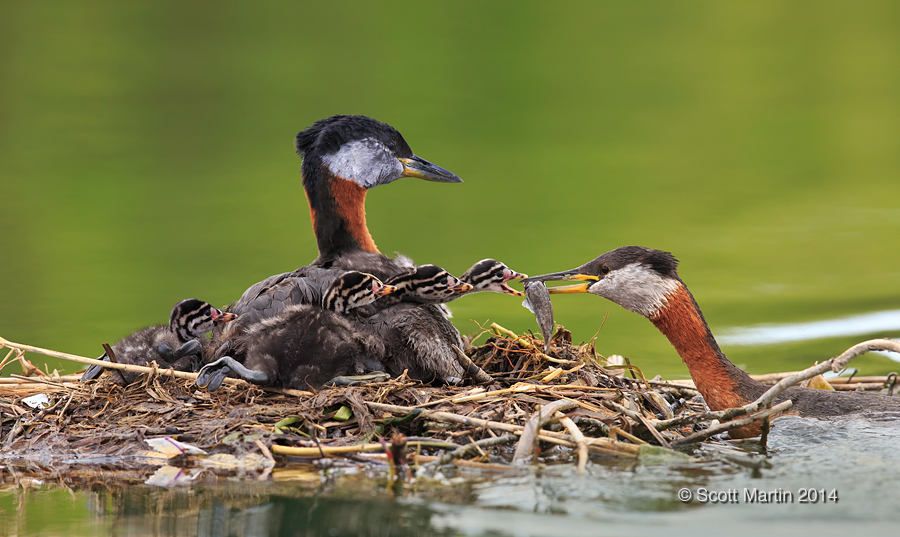
I was hopeful to photograph a Grebe chick on the back of a parent while swimming away from the nest, however this was not be. The next two images were as close as we were able to get, but that’s the beauty of bird photography, no matter how many great shots you’ve taken there is always a better one to be had next time. So we keep on looking for that ‘perfect’ yet elusive shot.
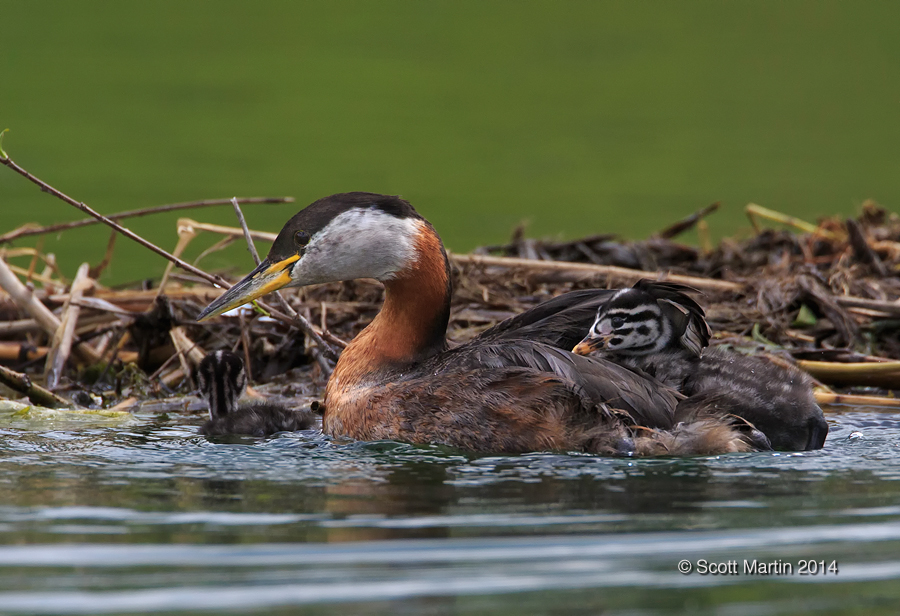
.
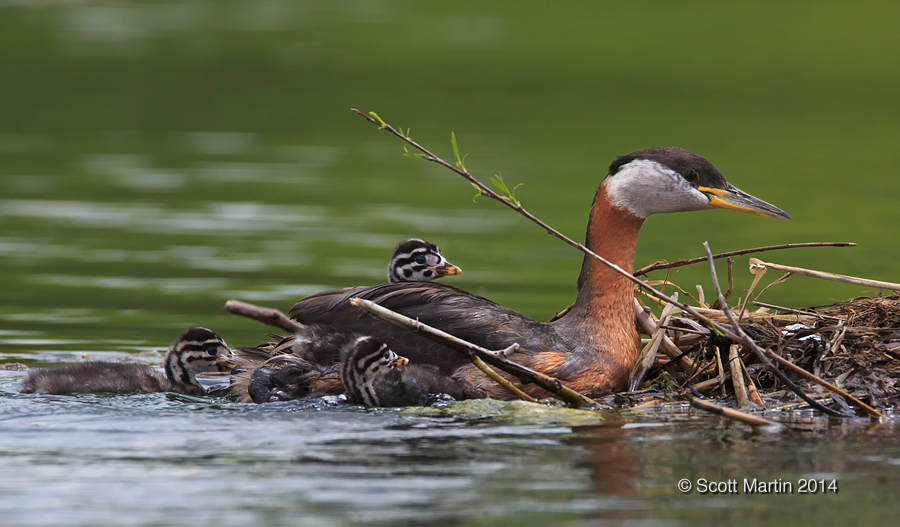
The Red-necked Grebe was an interesting bird to observe and photograph. They are also very photogenic as this concluding image demonstrates.
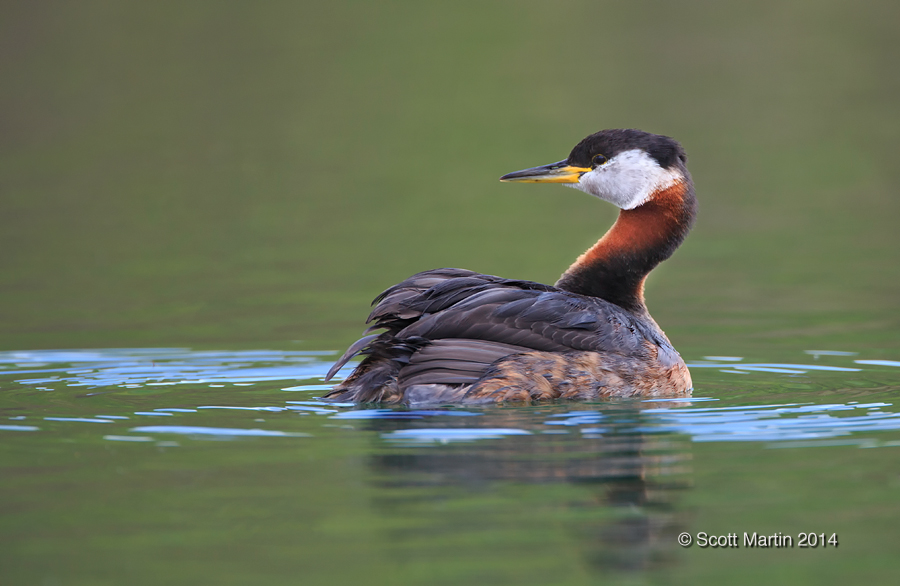
A couple of interesting facts regarding the Red-necked Grebe is that its feet are lobed rather than webbed and a group of Grebes together on the water are referred to as a ‘water dance’ of Grebes.
All of the images in today’s post were taken hand-held with a Canon 5D Mk III and EF 500 mm f4 L IS lens. Normally I use a monopod to support the weight of the lens, however as all of the images were taken while lying down to get a more desirable low angle, support for the lens was not available.
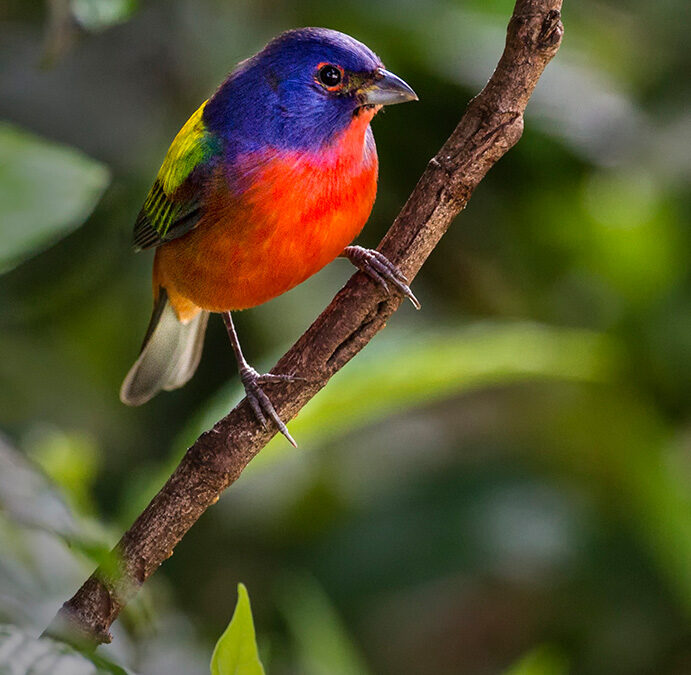
by Scott Martin Photography | May 13, 2014 | Birds, Blog, Shore Birds & Waterfowl, Song Birds, Sparrows
Todays post will only contain three different birds, however all three have stories and images that I trust you will enjoy.
The Painted Bunting is arguably the most colourful North American bird with its vibrant red, yellow, blue and green colours. It is a relatively common bird found in South-Central and South Eastern ares of the United Sates and into most of Central America. It’s a bird that is not often seen as it prefers the cover provided by thickets and underbrush although it does frequent back yard feeders for seed. It is such beautiful bird it is sometimes trapped and sold in Mexico & the Bahamas as a caged bird. Fortunately this practice is illegal in the United rates. For the last few years Painted Bunting have wintered on Merritt Island and these next two images of a male were taken there in March of this year.

.
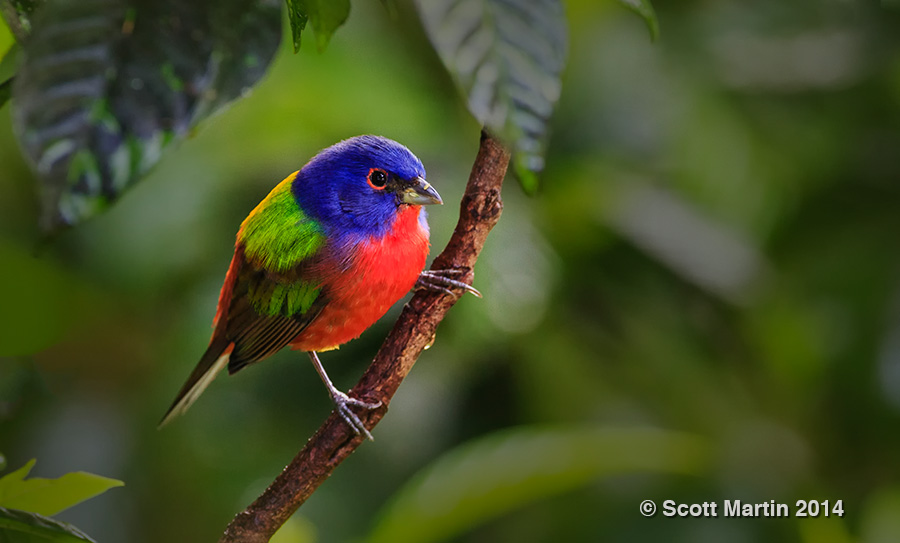
The All-American couple with a feeder to match!
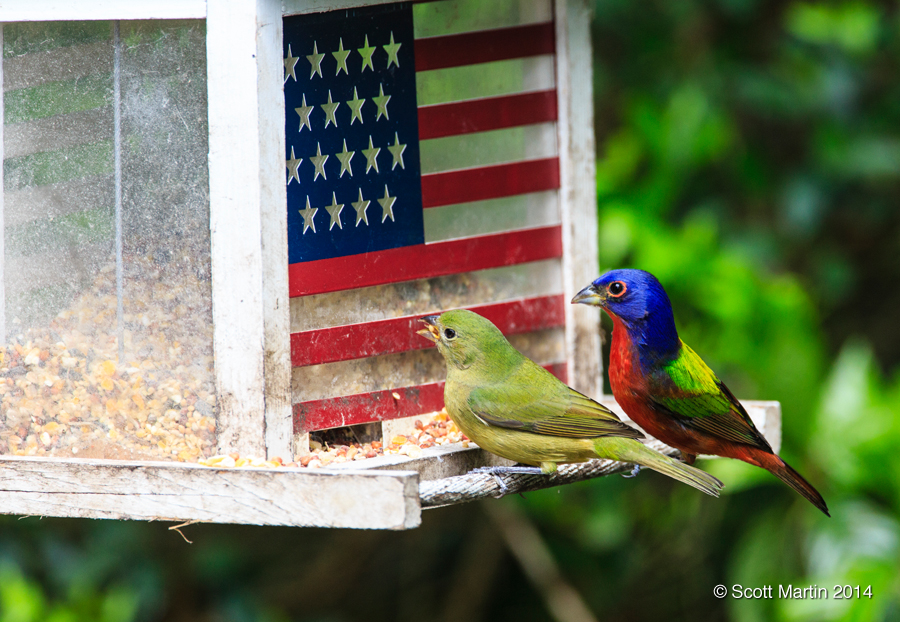
You can see other Painted Bunting images in the Sparrows, Grosbeaks, Buntings & Finches Gallery.
Approximately thirty miles south of Merritt Island you can find the Viera Wetlands which is a favourite location for bird photographers while visiting the Space Coast of Florida. The Viera Wetlands are home to hundreds of species of birds and the topography of the area makes it possible to get quite close to the birds if you are patient. Of the many Heron species, the Green Heron is one of my favourites. Although not a large bird its feather colouring and detail is impressive. They tend to stay in heavy reed cover at the edges of swamps and marshes where they stealthily hunt small minnows and fry that unknowingly swim under their perch. This year it was a pleasure to see a Green Heron fishing and a pleasant surprise to be able to photograph the action. Deb & I watched this particular bird move throughout the reeds for about thirty minutes until we actually saw him capture his prey.
Posing for the camera!
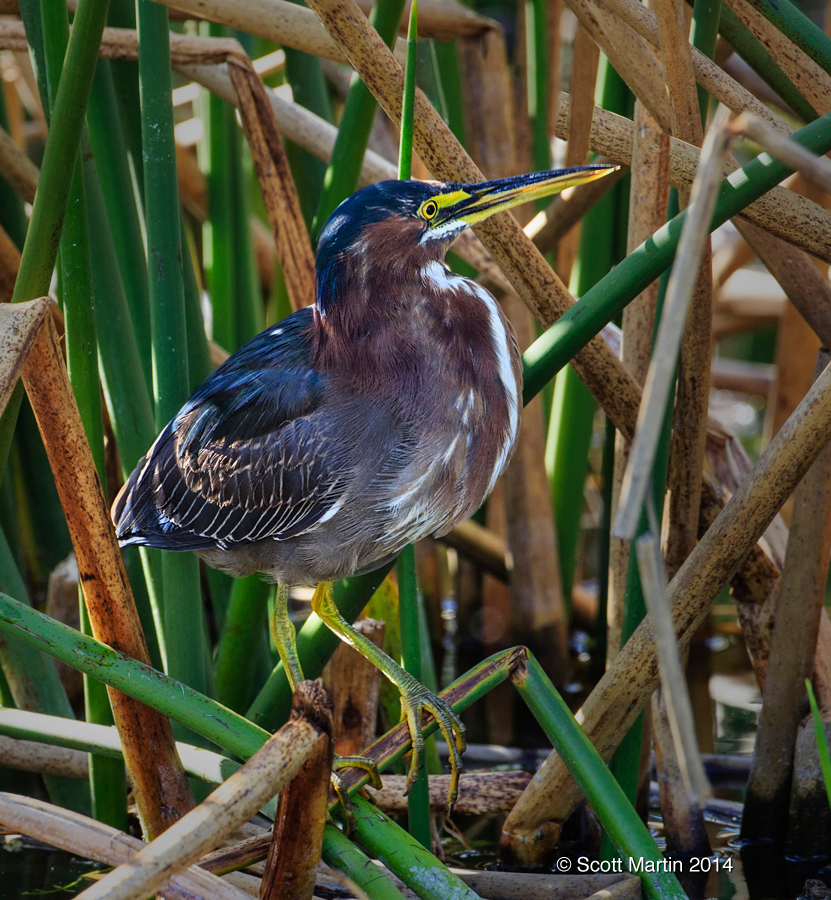
Intently looking for lunch.
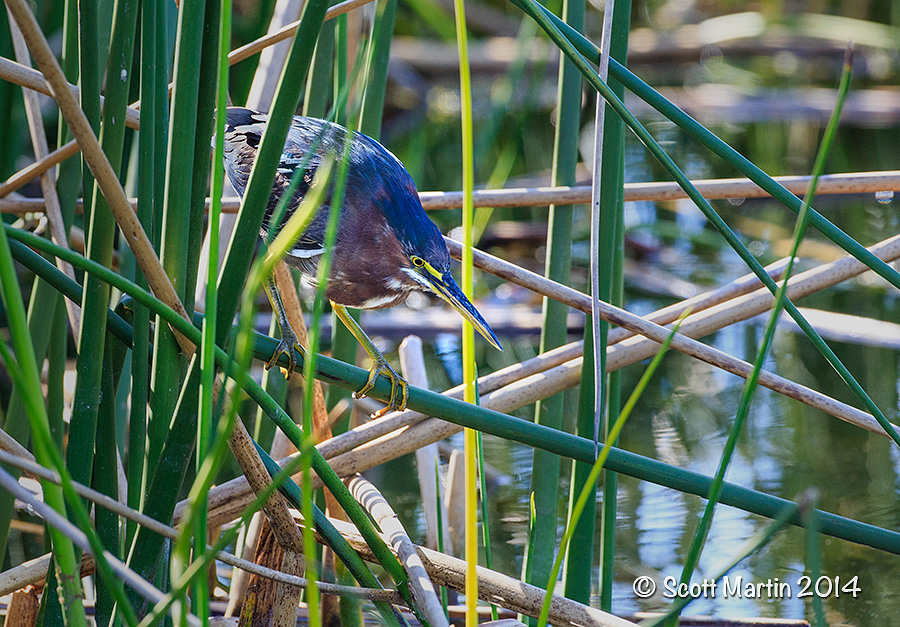
Having a closer look.
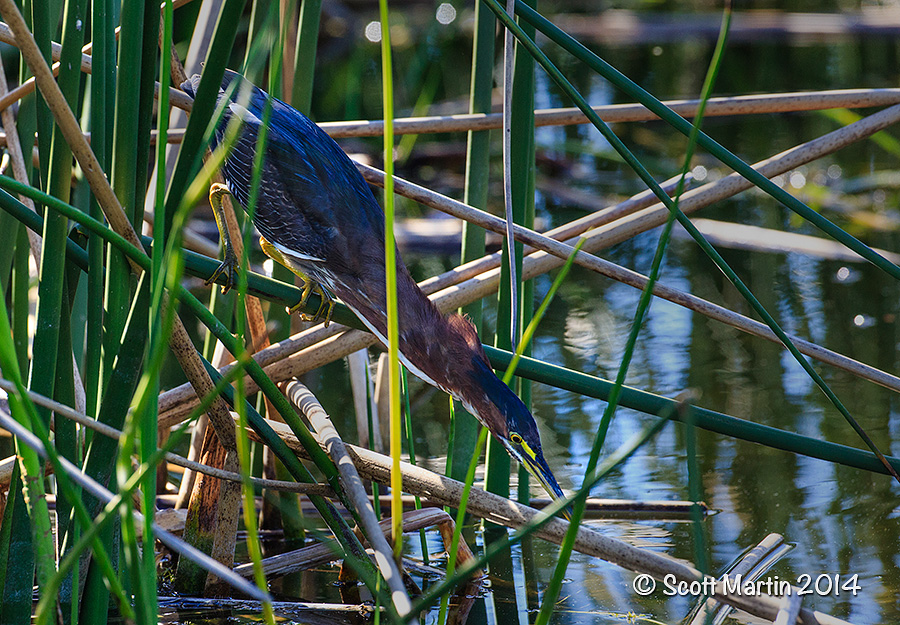
Taking a stab at it.
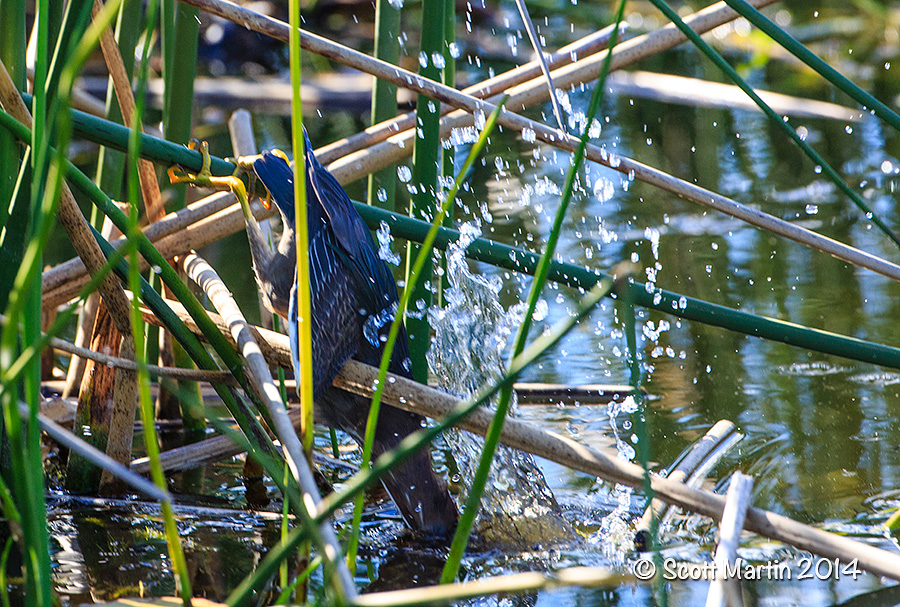
Success!
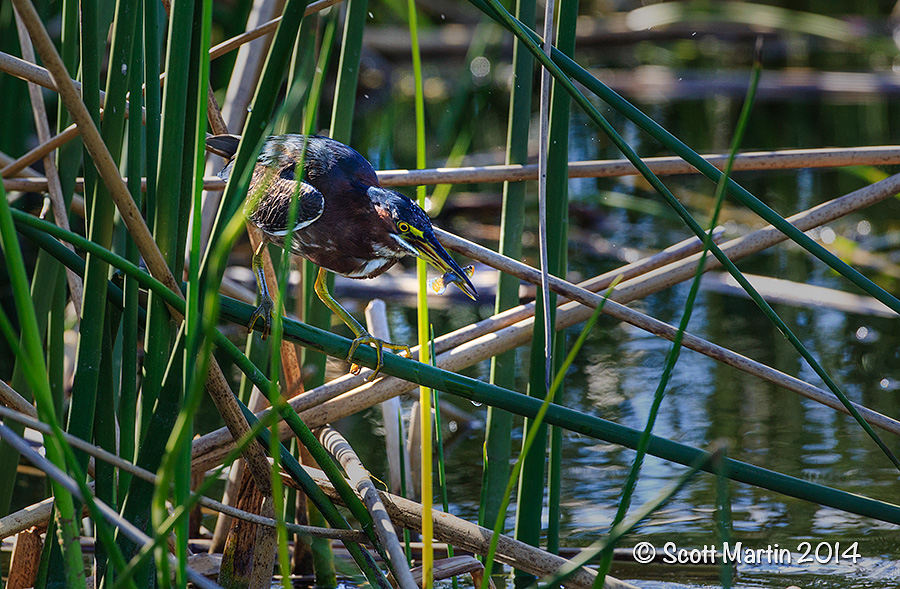
The last bird in today’s post is the Black Skimmer, a common bird with a most uncommon beak. In fact, it is like none other bird in North America as the lower mandible is about half to three-quarters of an inch longer than its upper mandible. A most unique design that makes digging for worms or picking berries next to impossible, yet is perfectly designed to do what the Black Skimmer was made to do….skim along over the calm water with the extended lower jaw just below the water’s surface and extracting food from the water as it travels up into the mouth of the bird before exiting in a stream of water from the base of the mandible.
Although Deb & I have watched skimmers skim in the past, it was not until this year that we were able to take some decent photographs of the action. So it was a great experience that was only heightened by the fact that they were about ten years in the making!
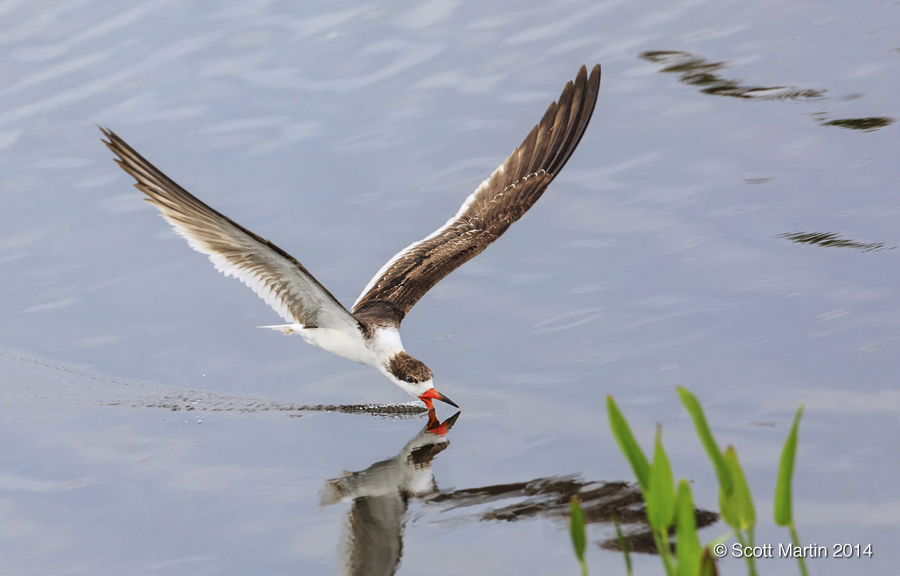
X marks the spot.
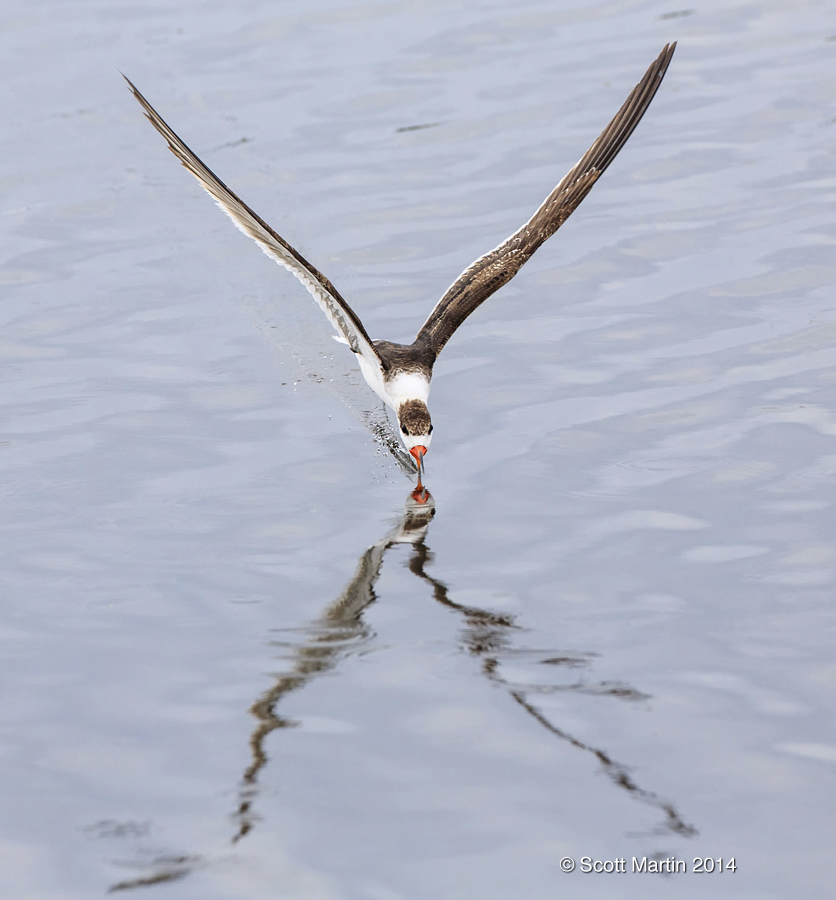
.
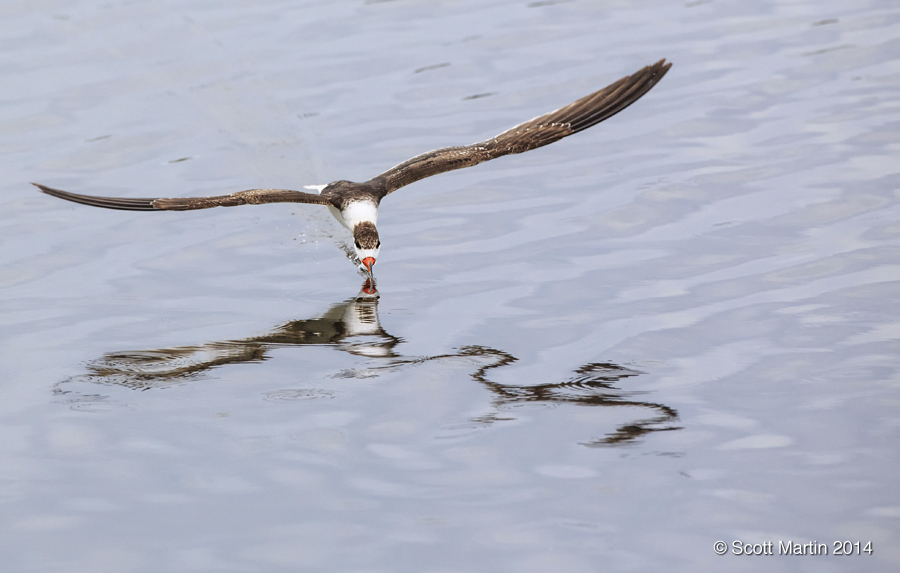
.
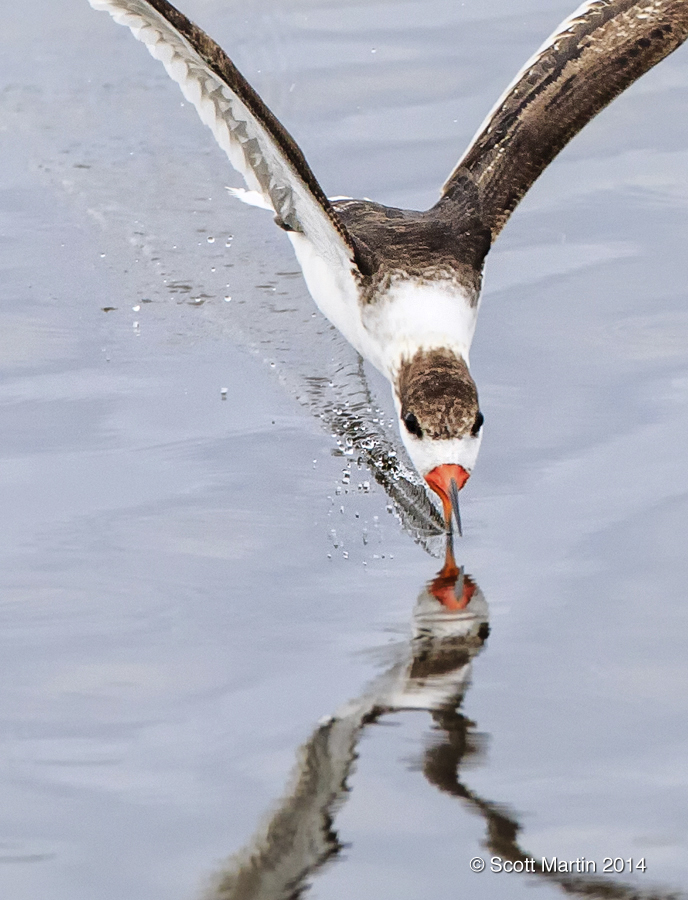
This last skimming image was taken in the rain and in a different location that provided a dark back ground, not ideal for isolating the Black Skimmer from the back ground but nevertheless creates an interesting result.
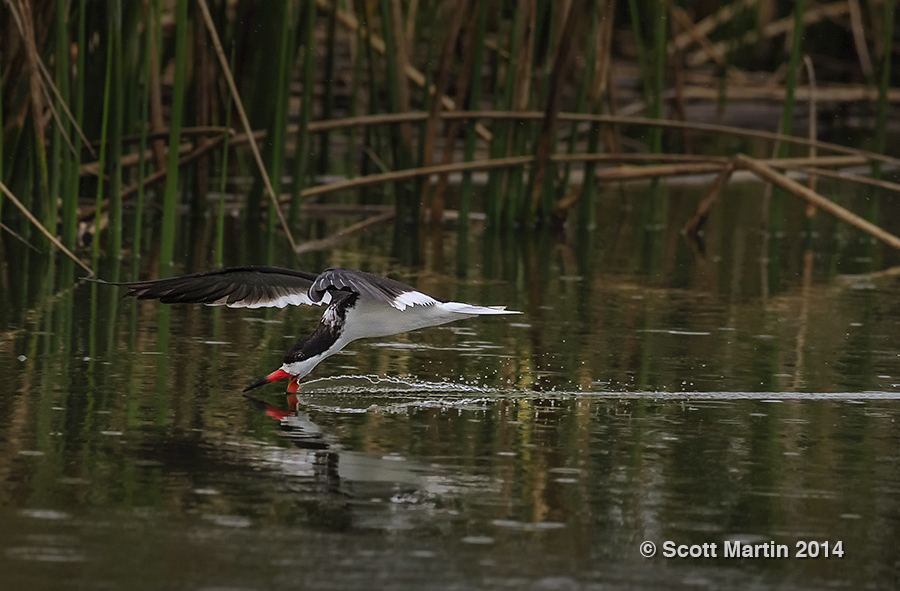
A number of other Black Skimmer images, including close up pictures of the unique mandible and normal in flight images can be seen in the Gulls, Terns & Skimmers Gallery.
All of the images in today’s post were taken with the Canon 5D MK III and EF 500 f4 L IS lens, sometimes with the 1.4x TC attached (allowing the 500mm lens to function as a 700mm lens).
This brings our March Break 2014 bird photography to a close and we will return to our tour of Europe for the next few posts. In the mean time we are heading into another time of year when there are an abundance of great looking birds fairly close by, including many species of Warblers that are passing through the Oshawa area on their way north country for nesting and breeding. Hopefully we will be able to have a Warbler Blog post this spring!
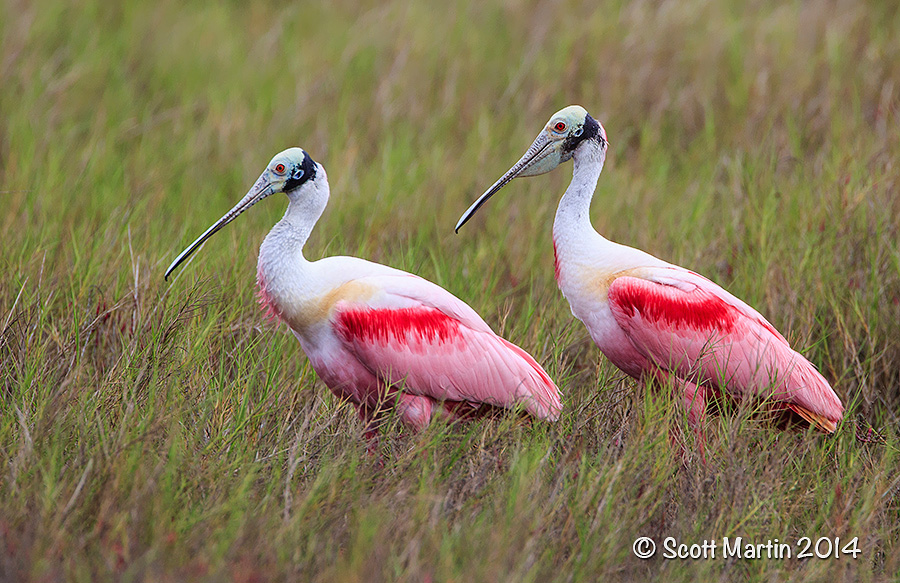
by Scott Martin Photography | Apr 27, 2014 | Birds, Blog, Raptors, Shore Birds & Waterfowl, Woodpeckers
Every year we look forward to spending time in Florida over the March Break. Our typical schedule is to spend three or four days on the Atlantic coast in Melbourne and then a week at our timeshare in Kissimmee. These locations provide easy access to our favourite bird photography sites which include the Viera Wetlands, Merritt Island National Wildlife Refuge, and Joe Overstreet to name a few. March is a great time for bird photography as many of the birds are in their annual breeding plumage and the winter migrants have not yet left for their flights north. This winter we were able to photograph a number of different birds, and although no new species were captured we did manage to photograph Black Skimmers skimming, something we’d been trying to do for many years. Todays post is a compilation of the birds we saw this March, with the exception of the skimmers which will be part of another post.
Over the years we’ve photographed many Roseate Spoonbills, but always in flight or perched in trees. This was the first time we were able to get close to them on the ground (Blackpoint Trail, Merritt Island).

.
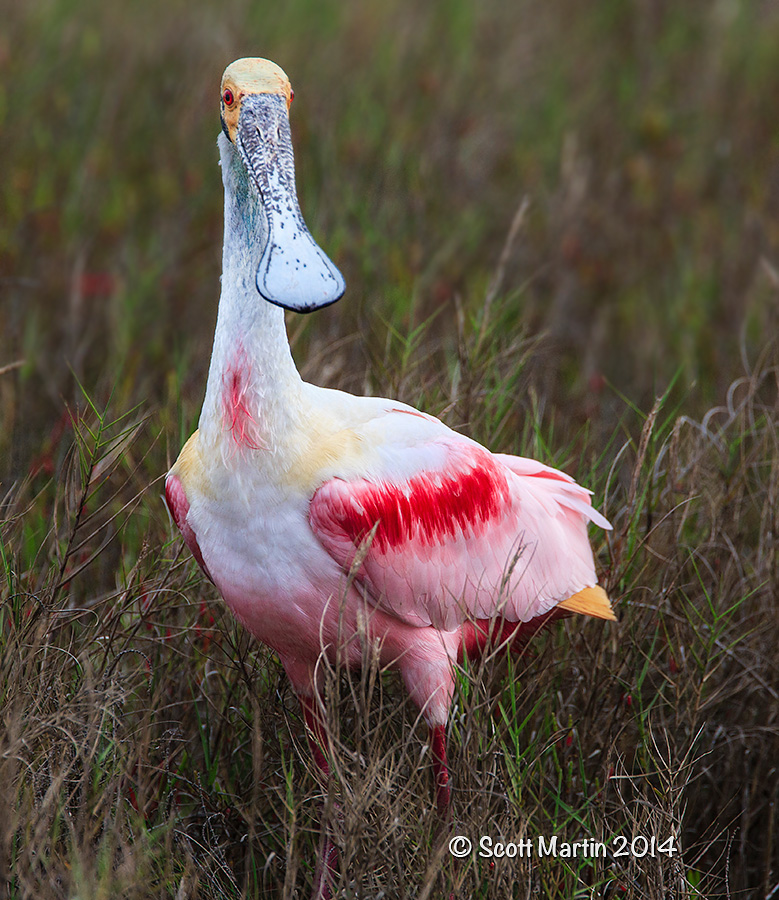
Great Blue Heron Family (Viera Wetlands).
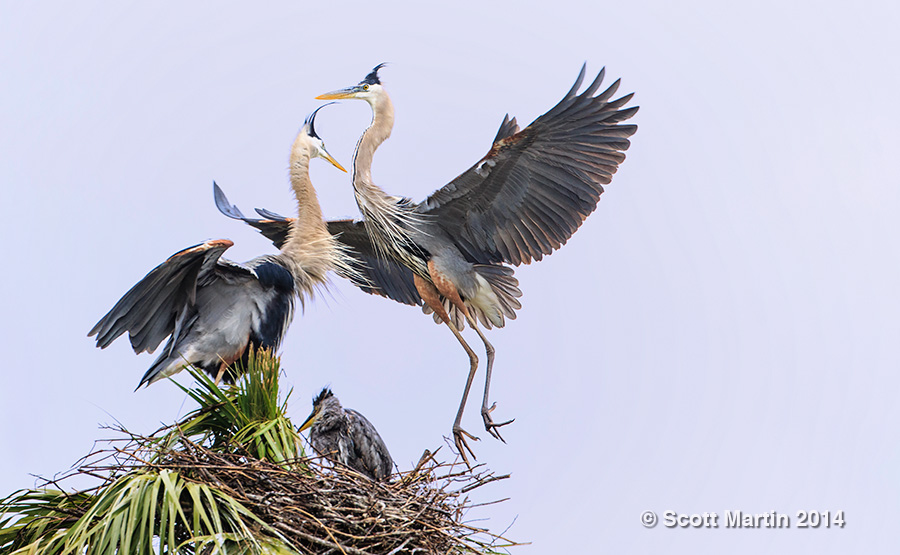
.
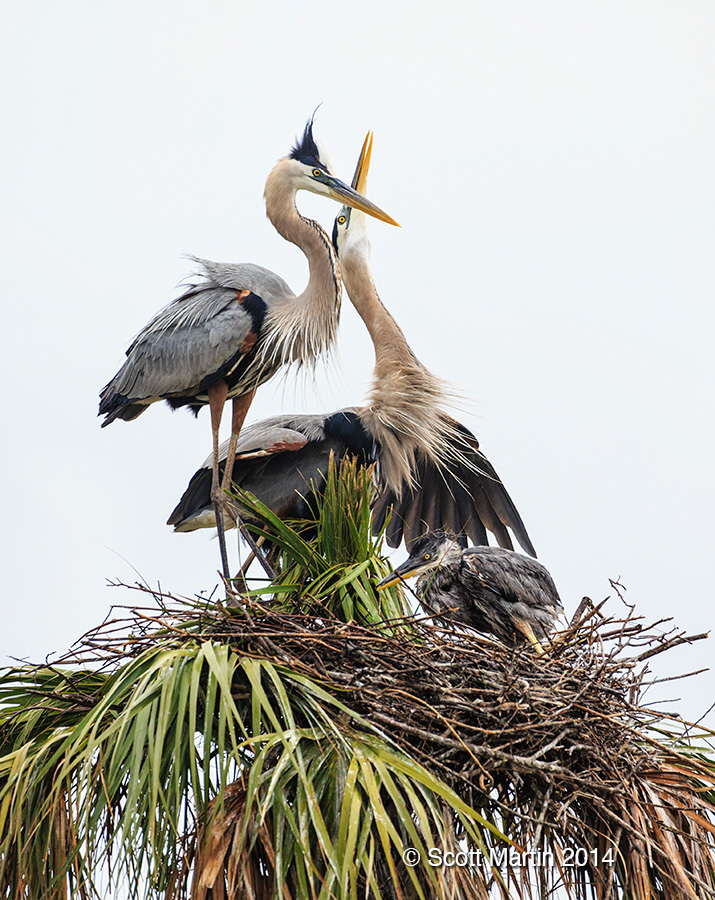
.
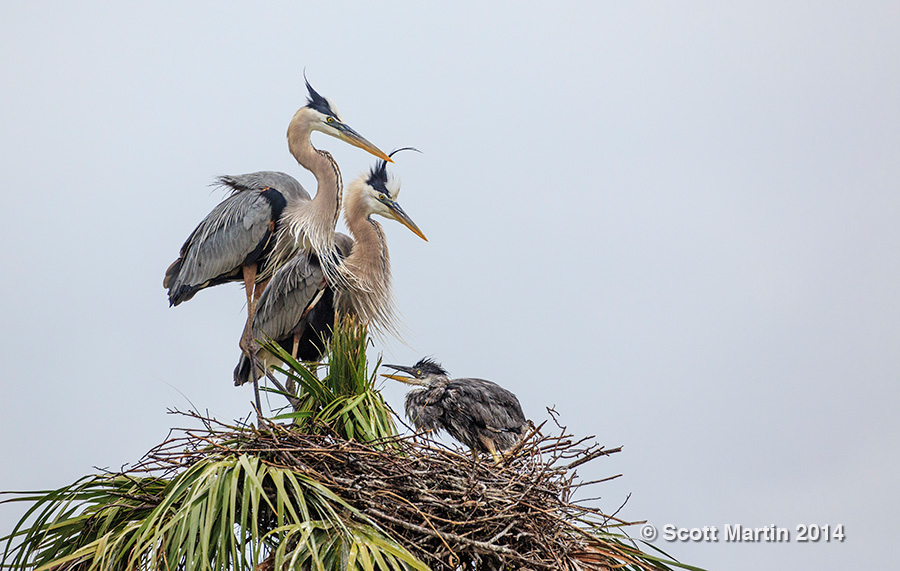
.
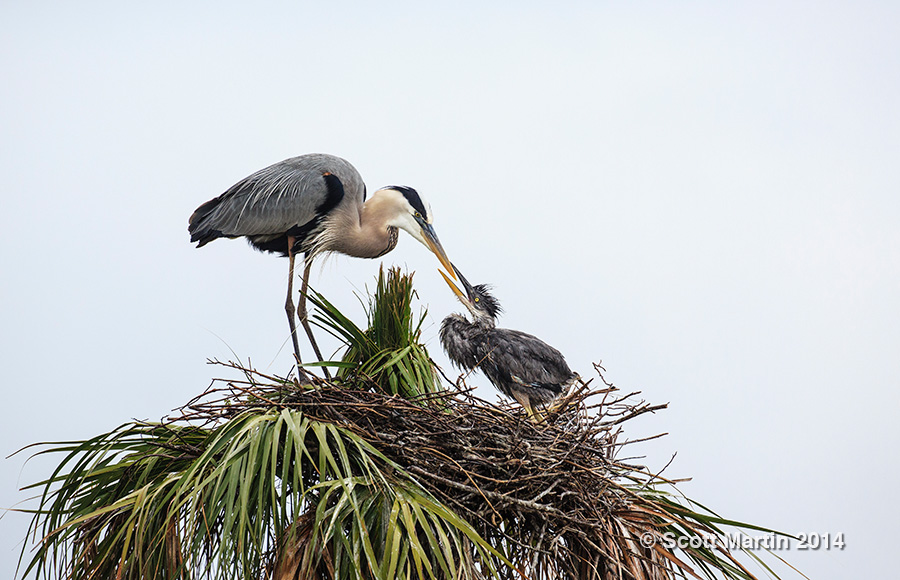
.
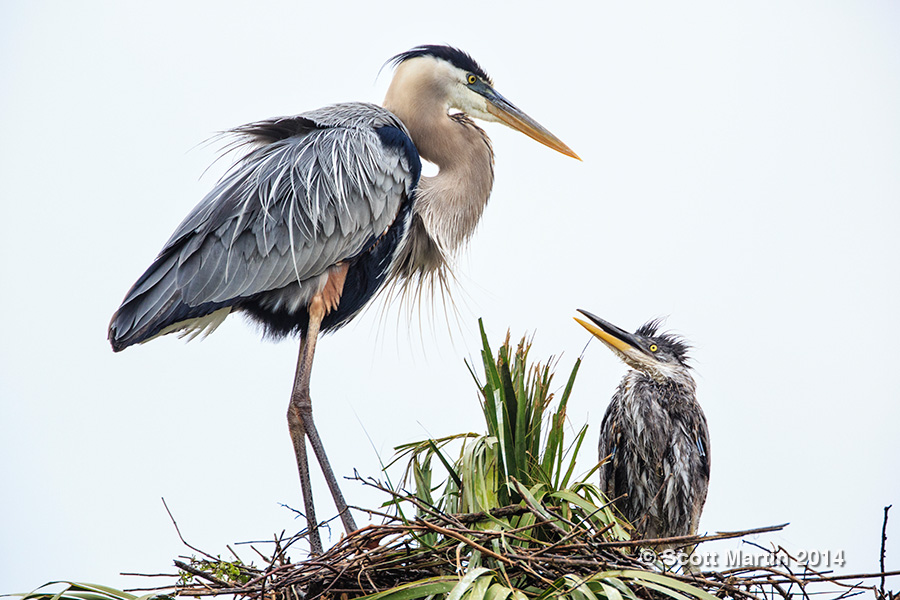
.
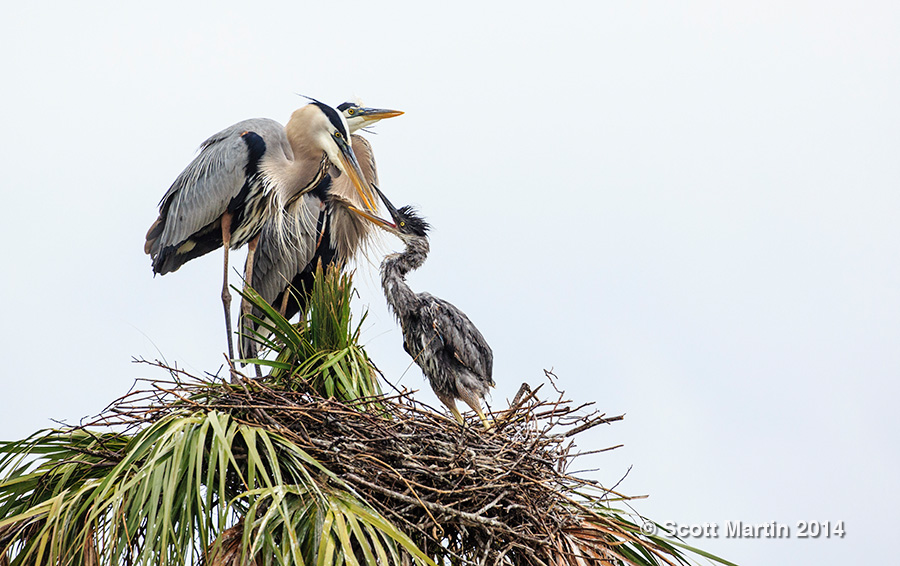
Another Viera favourite is the Limpkin, which is one of two birds that are locally endangered in Florida that eat Apple Snails almost exclusively. This first image catches the Limpkin shaking the rain drops off.
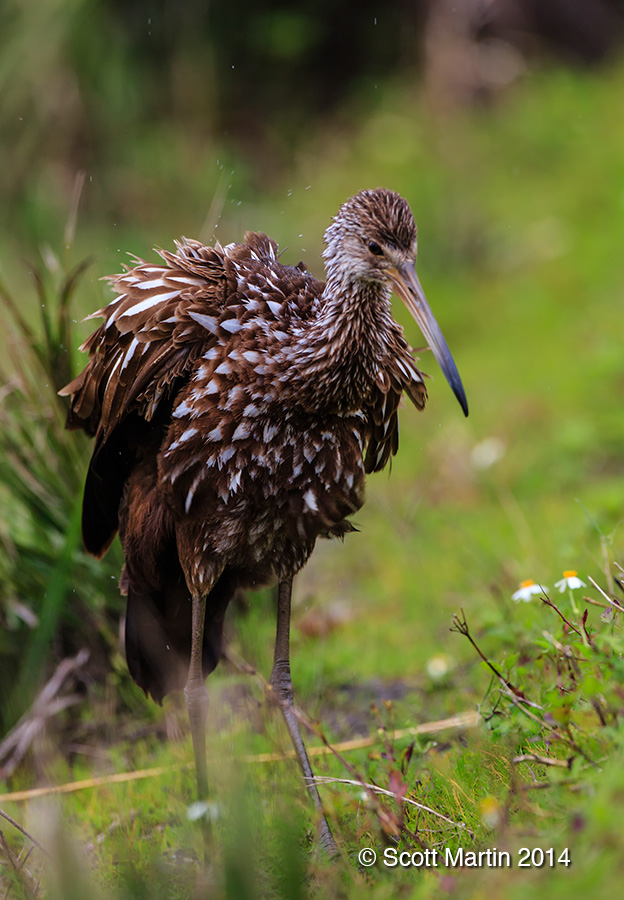
.
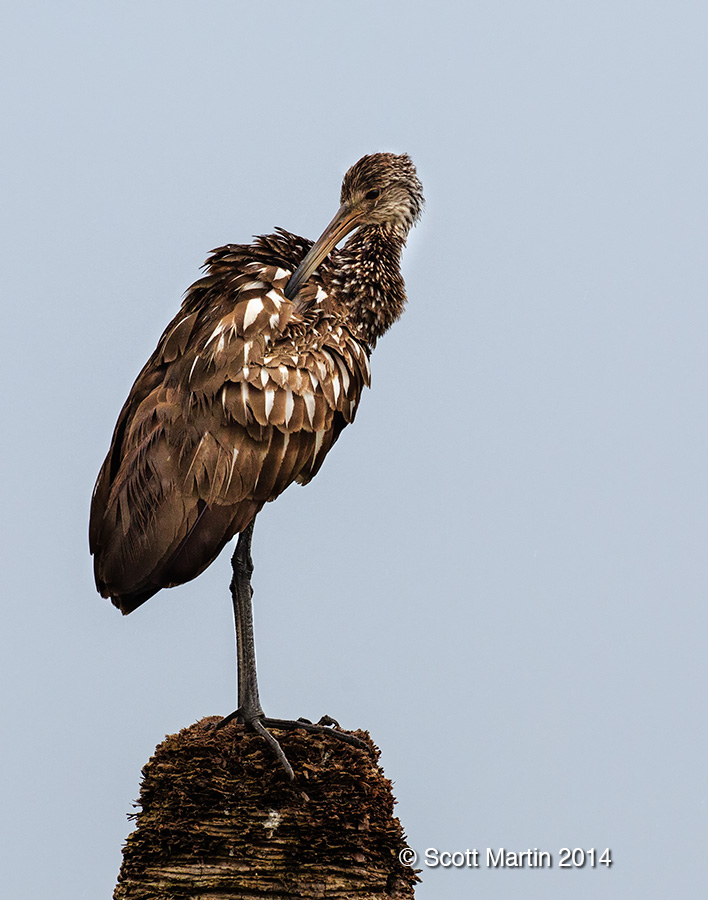
The other Apple Snail enjoying, locally endangered Florida bird, is the Snail Kite. This one was seen at Joe Overstreet.
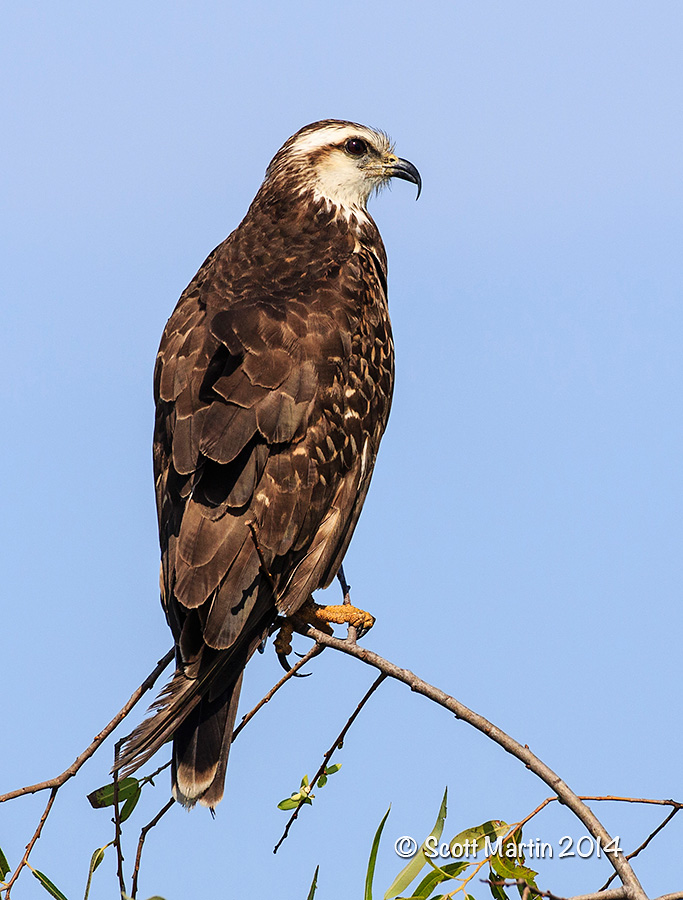
.
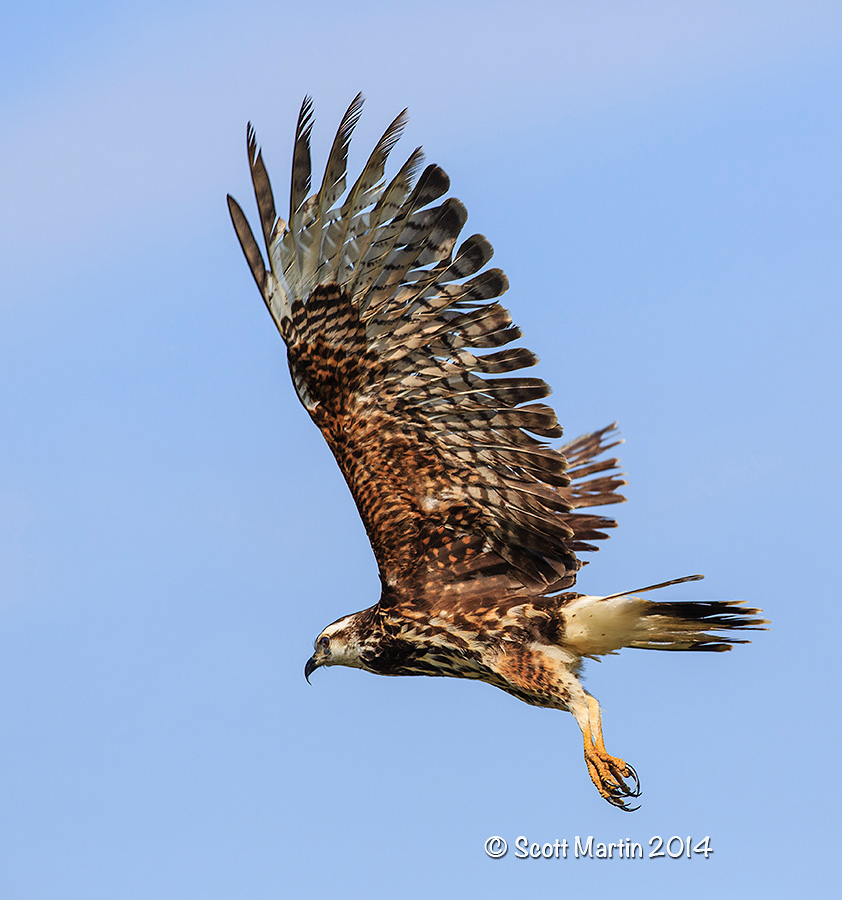
Other Snail Kite images from past years can be found in the Hawks, Falcons & Kites Gallery. While at Joe Overstreet we found this juvenile Yellow-bellied Sapsucker.
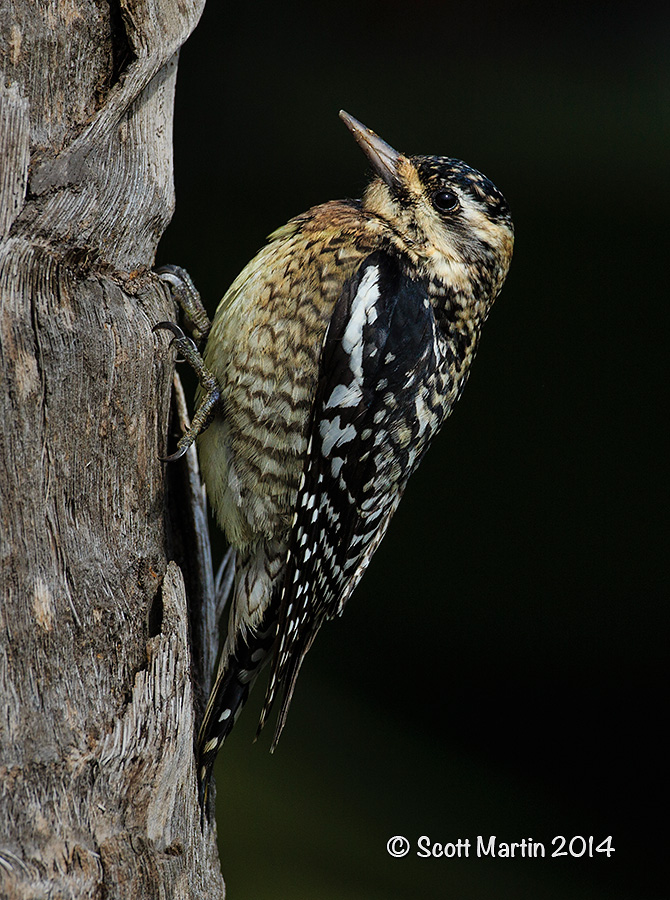
.
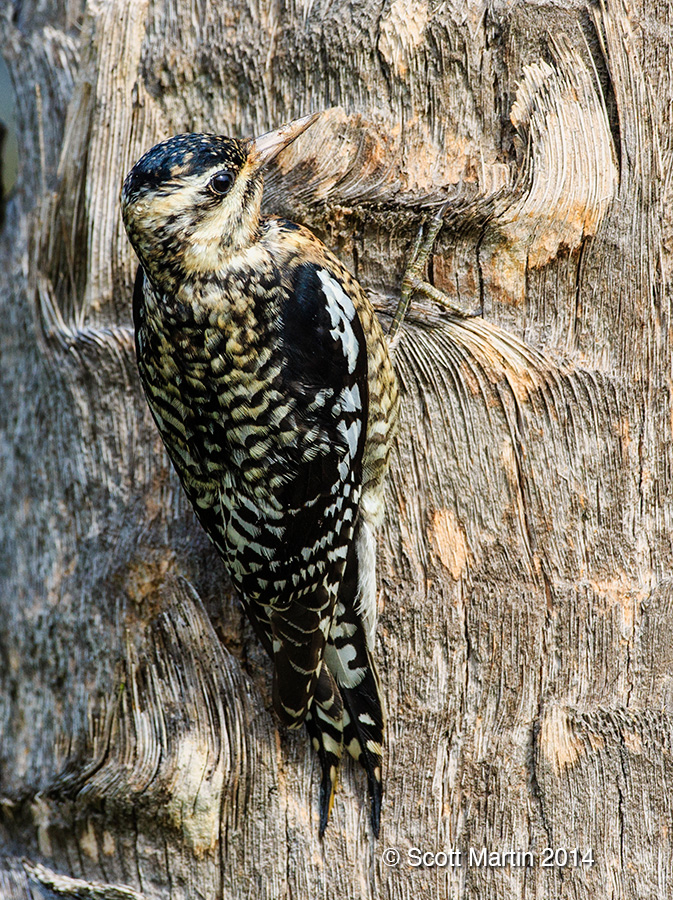
Another common Florida Woodpecker is the Red-bellied Woodpecker (Merritt Island).
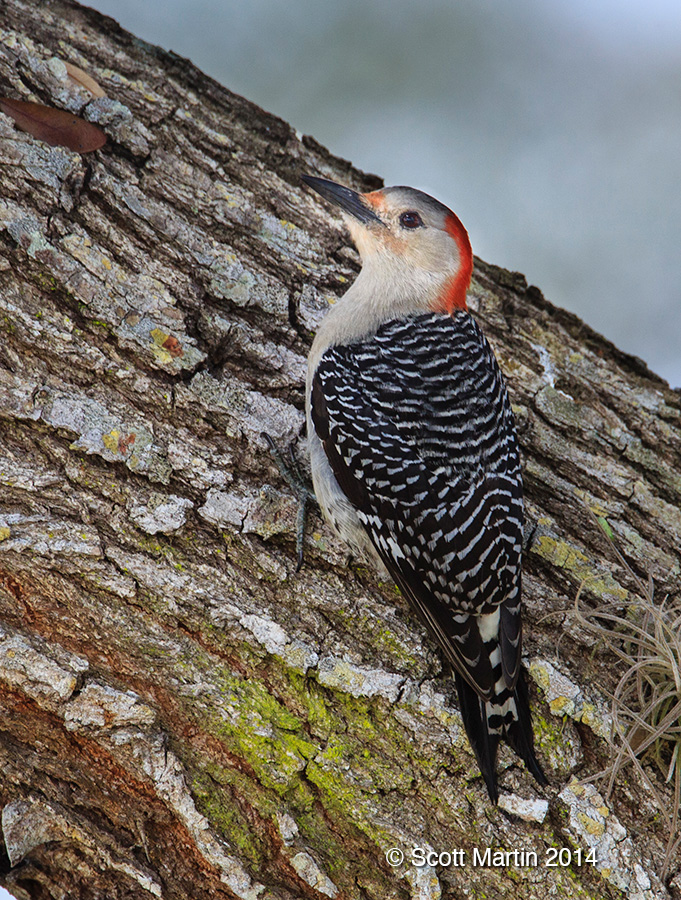
The American Bittern is a large bird that is not easily seen as it blends so well into its chosen surroundings where they extend their necks to parallel the grass, which along with their striated coloration makes them almost invisible (Viera Wetlands).
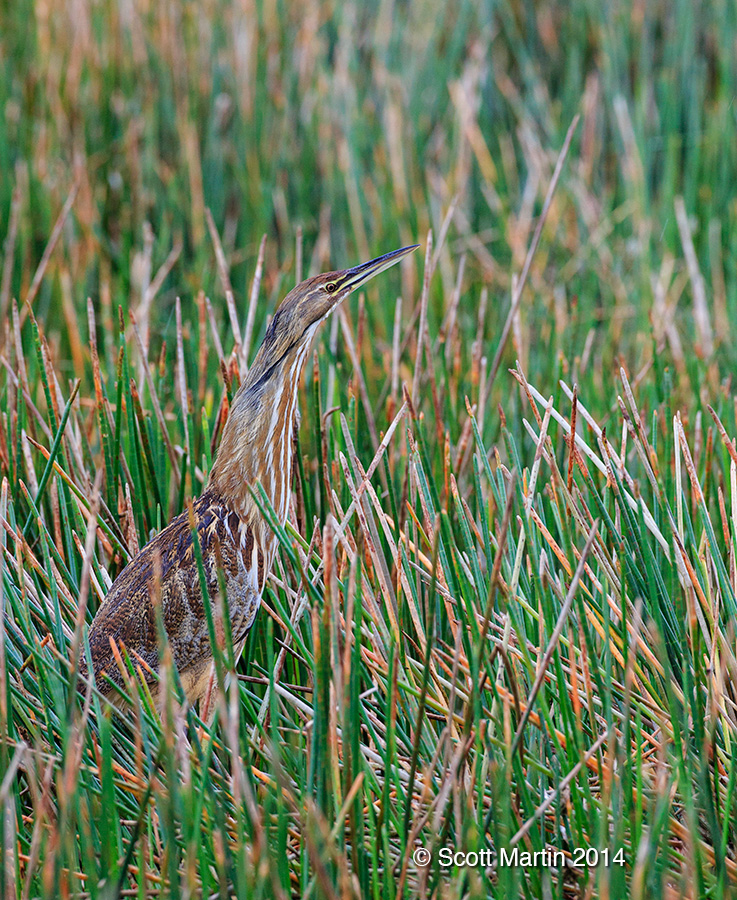
.
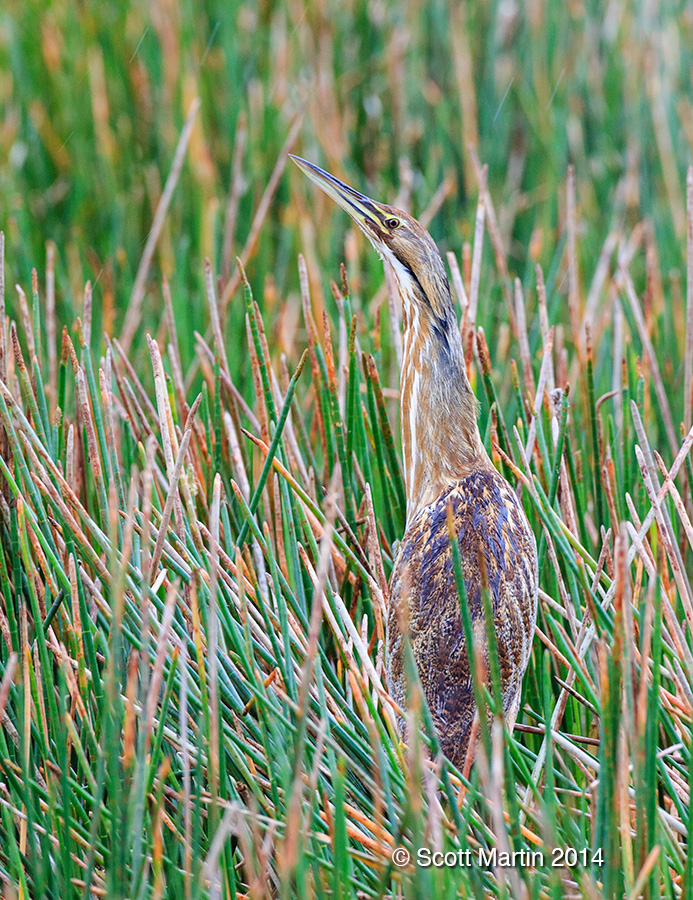
A bird that is seemingly never inconspicuous is the Anhinga, which because it lacks oil secreting glands to waterproof its feathers, must dry out in the sun after being in the water (Viera Wetlands).

America’s official bird, the Bald Eagle is a regular patroller of the Viera Wetlands airspace.
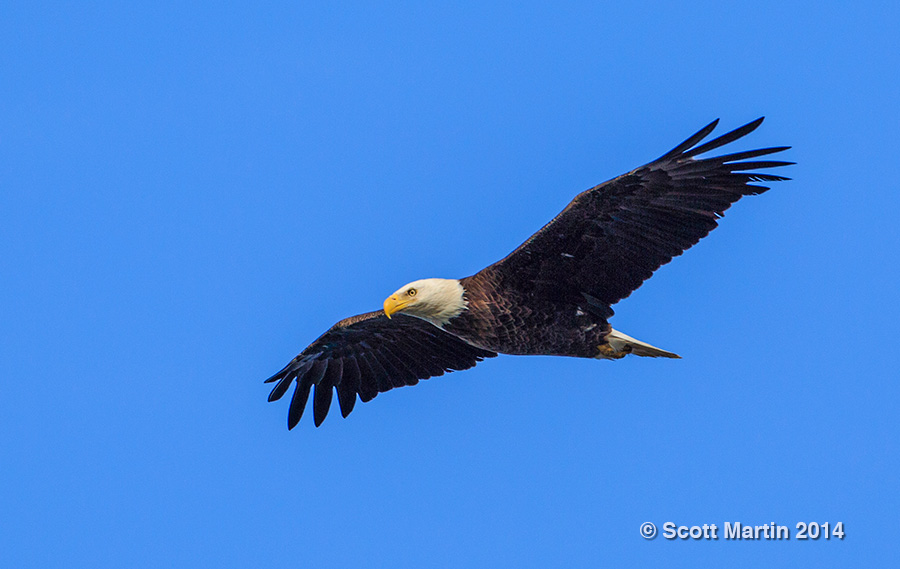
One of the cutest birds in Viera was this little Pied-billed Grebe.
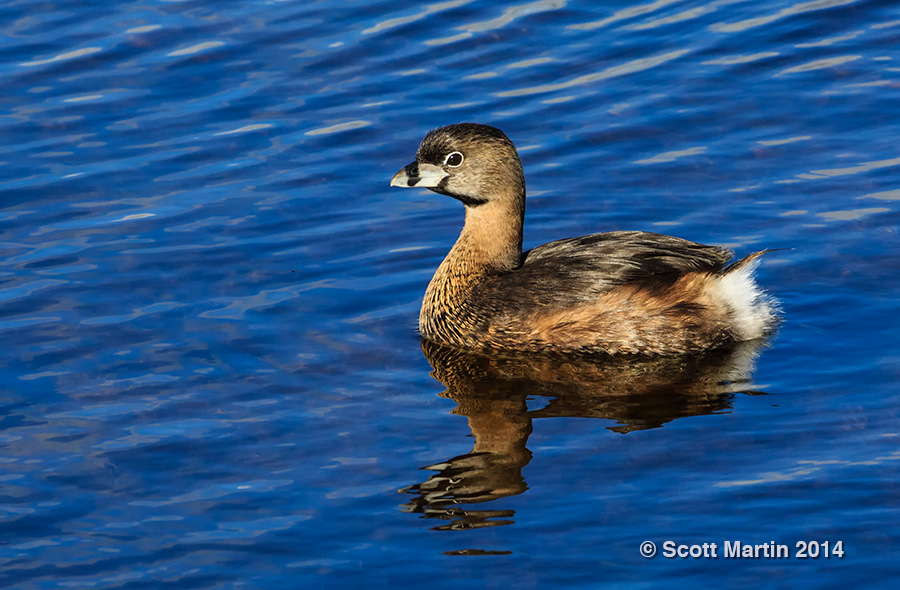
If the Grebe is a bird everyone likes, perhaps the other end of the spectrum belongs to the gulls, which rarely garner much attention, although when one flies overhead with a big fish, you just have to take the shot (Joe Overstreet).
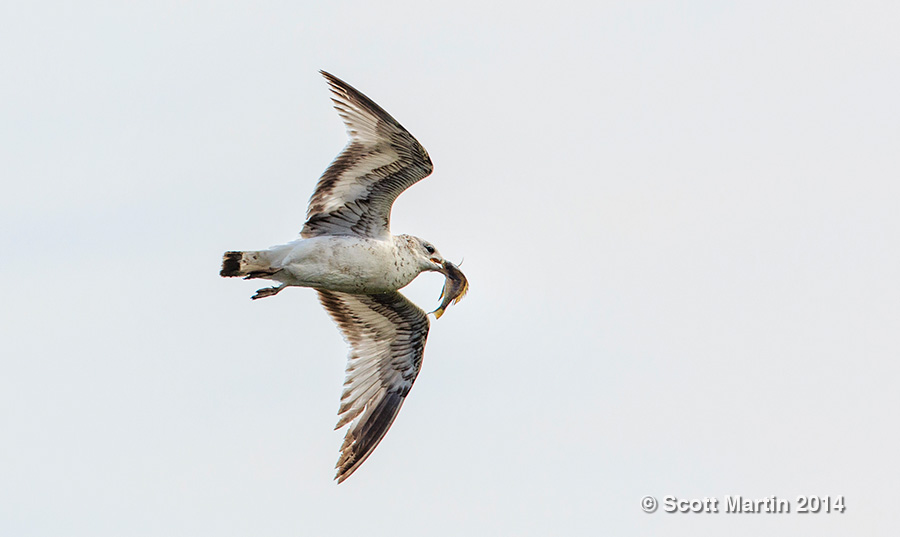
These Terns were photographed at Viera and Joe Overstreet.
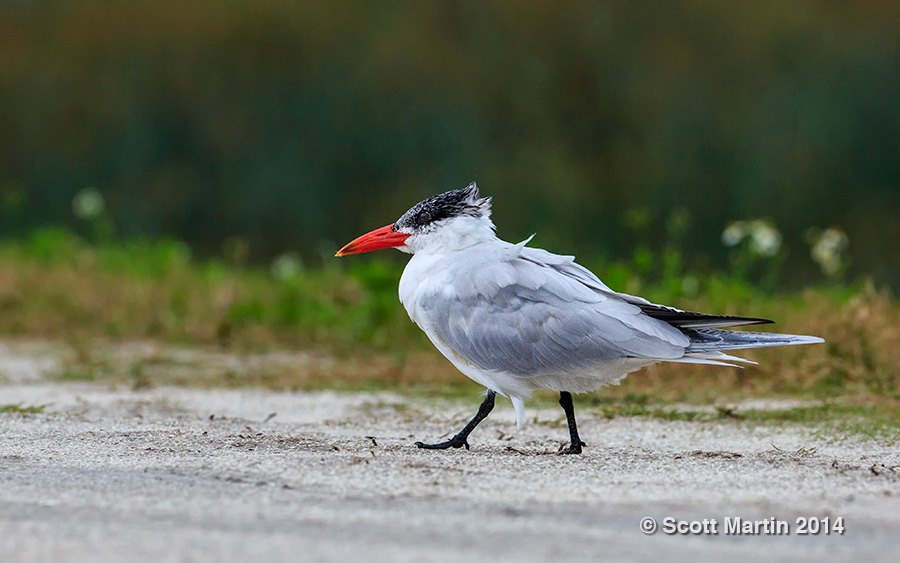
.
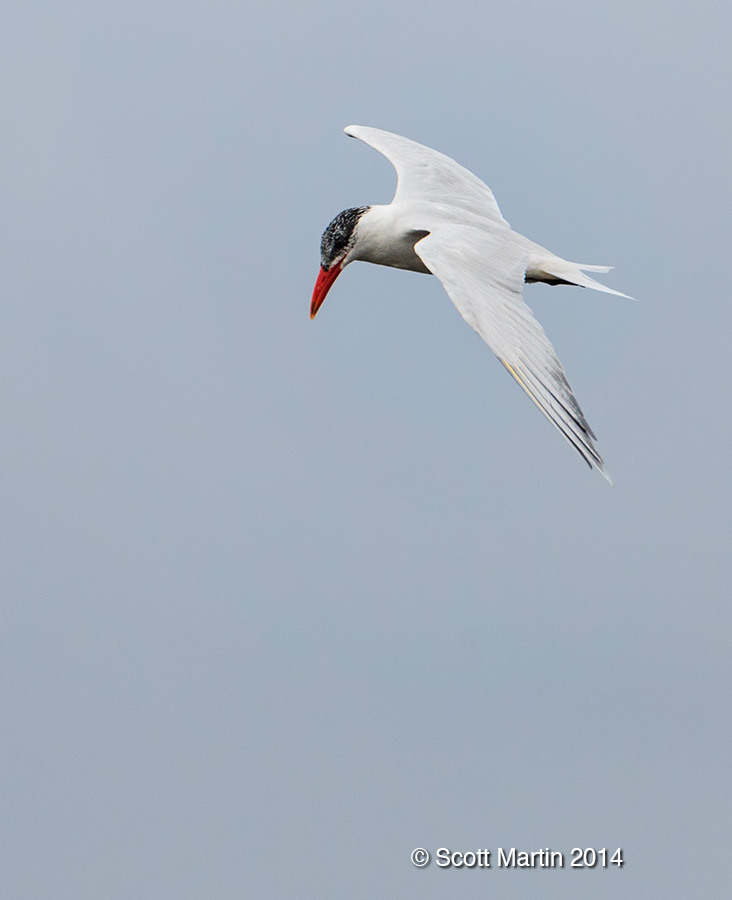
.
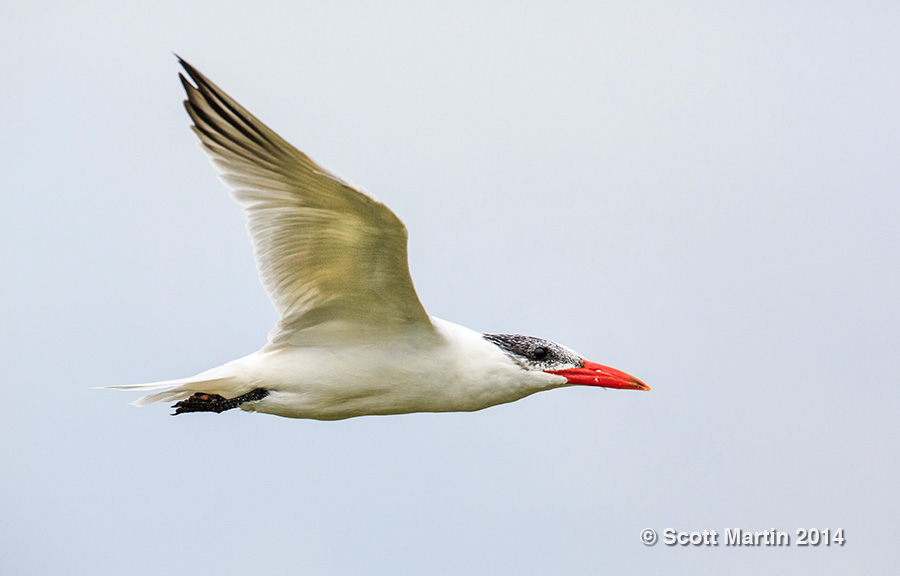
To close this post, something completely different; the Florida Soft Shelled Turtle (Viera Wetlands). It is the largest soft shelled turtle in North America and is very fast on both land and in the water as evidenced by the webbed feet visible in the picture.
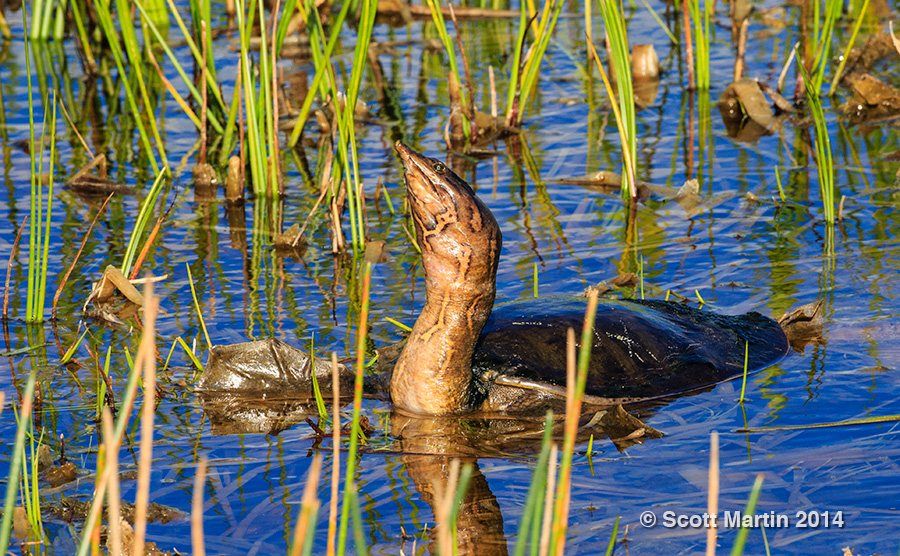
I trust you’ve enjoyed this rather eclectic grouping of some of the birds we enjoyed seeing in Florida this year. In the next post we will feature three birds which provided some memorable photographic opportunities, the Painted Bunting, Little Green Heron and Black Skimmer.
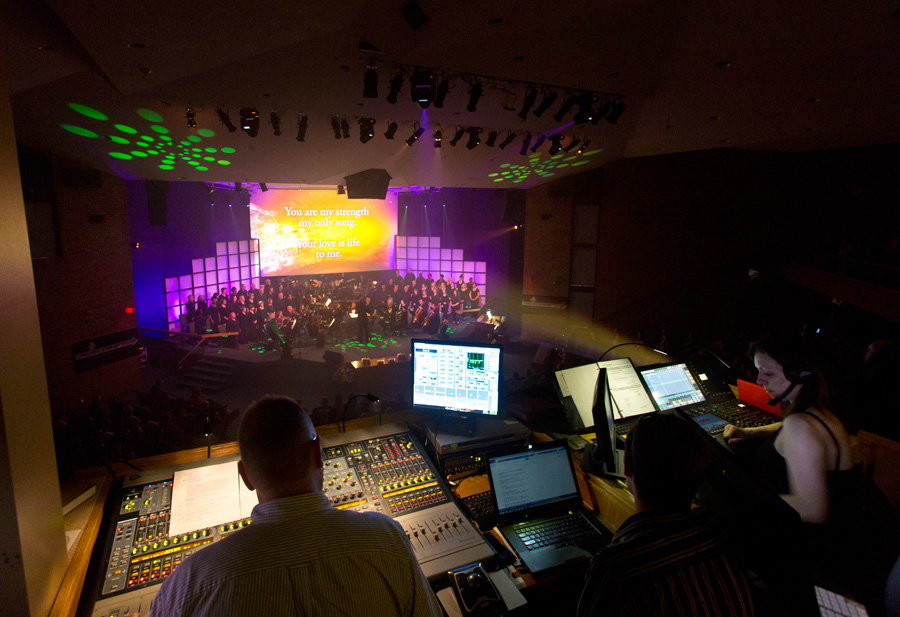
by Scott Martin Photography | Apr 22, 2014 | Blog, Commercial, Educational, General
Easter marks the high point of history for the Christian as we celebrate the crucifixion, burial and resurrection of Christ, without doubt establishing his credentials as the Saviour. This year our church, Calvary Baptist Church, performed an Easter Musical entitled “Saviour” on Good Friday Morning which was attended by over one thousand people.
Being devoid of musical talent, my contribution was to photograph the presentation, the results of which are the subject of today’s post.
Event photography always presents challenges, not the least of which are there are no ‘do overs’, you only have one chance to get it right. Secondly, you need to capture the feel of the event, so that the viewer of the images gets a glimpse of what it would have been like to be there, and those who were performing at or attending the event should be able to relive the experience through viewing the photographs. I trust both of those ideals are met with these images.
Event photography presents numerous and significant technical challenges that must be successfully navigated in order to achieve good results. The venues are generally dark, and lighting is typically achieved through multiple point sources (spotlights) that continually move about and change colour as well. We will talk more about dealing with various challenges in a minute using images to provide examples.
Event photography, especially in low light situations, is one of those things that requires a good camera body that functions well at the high ISO’s required to generate shutter speeds fast enough to capture the action without blurring the subjects. The Canon 5D MkIII used for all of today’s images is a terrific high ISO performer and all the images in this post were taken at ISO 4000. I purposely did not perform any noise reduction in the post processing of these images so that you can see how clean the files are right of the camera, even at ISO 4000. Fast glass is also a big help in low light and if you look at the EXIF data you will see many of the images were taken at f/2.8. Four different lenses were used for this photo-shoot; 16-35/2.8L (wide angle zoom), 24-105/4L (short telephoto zoom), 100/2.8L (portraits), and 70-200/2.8L (telephoto zoom).
When covering events, get there early and look for some unique compositions and angles that are all about capturing the feel of the performance.

I aways start with the wide angle and get shots that show the performance on a large scale as well as capturing the venue and the audience. Move around the auditorium (if allowed) and get a number of different views.
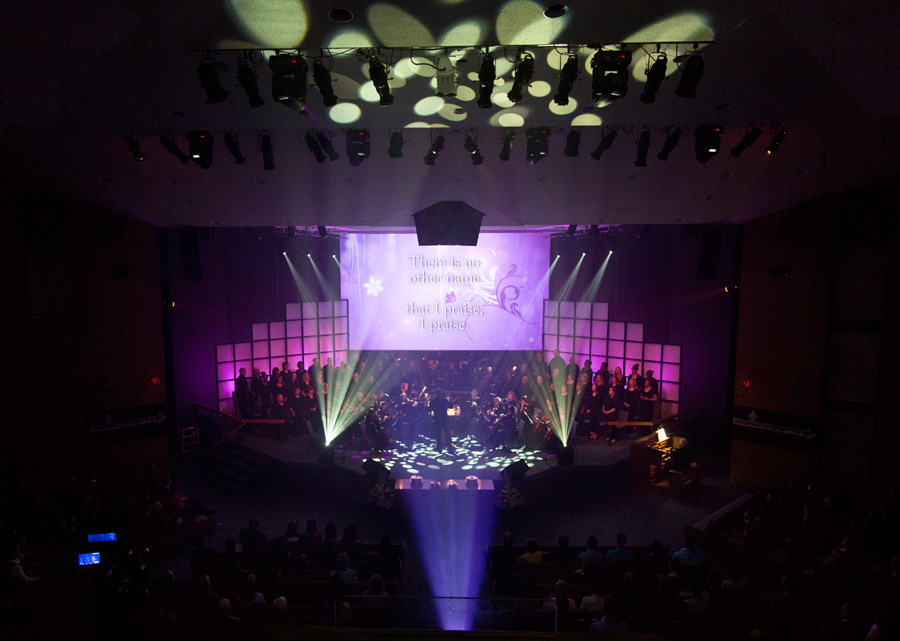
Side views of the auditorium are the best vantage point to highlight the audience.
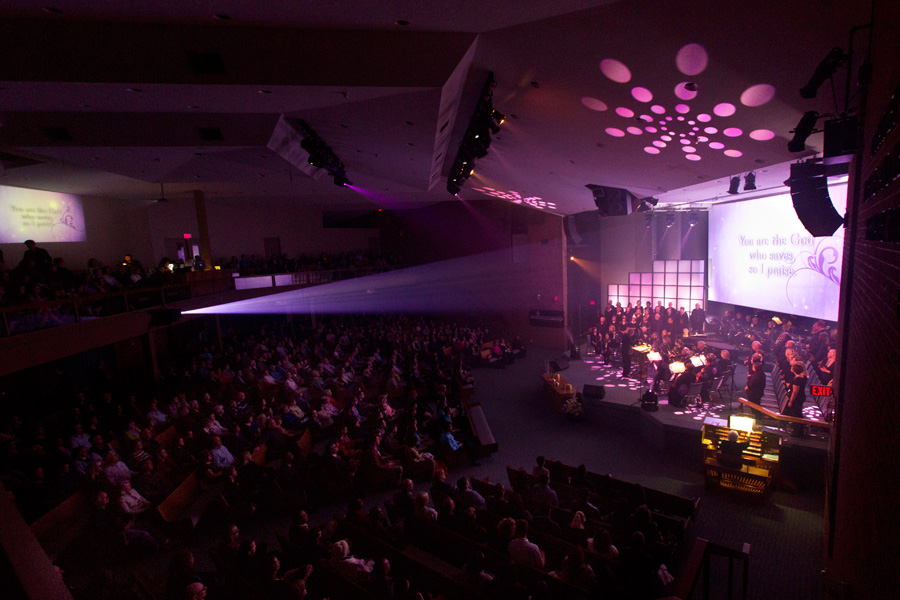
And from the other side of the auditorium.
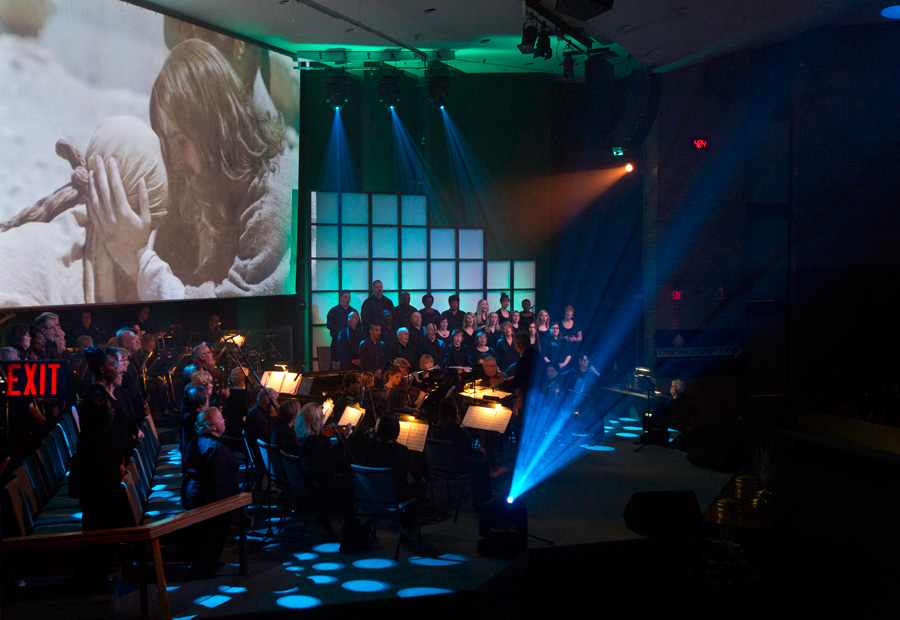
Event lighting changes quickly but the effects are dramatic and powerfully contribute to the effectiveness of the performance. It’s difficult to capture those rapid changes photographically and retain the ‘feel’ of things. These next two images are from a similar vantage point with the same spot lights visible in both. In the first, the primary spots are yellow (1/160 sec f/4).
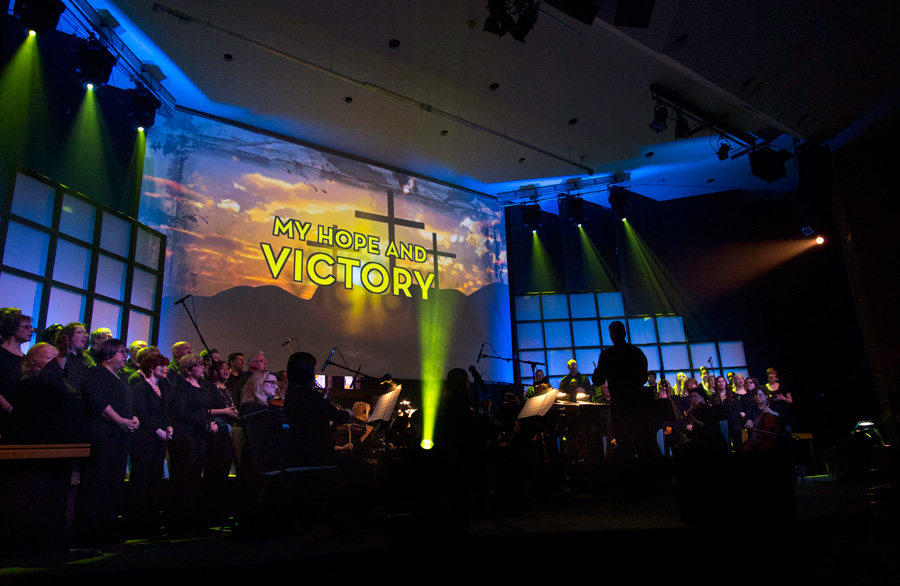
In this shot the spots are white and I’ve over exposed it a bit to highlight the beams of lights diffusing in the smoke. (1/125 sec f/4).
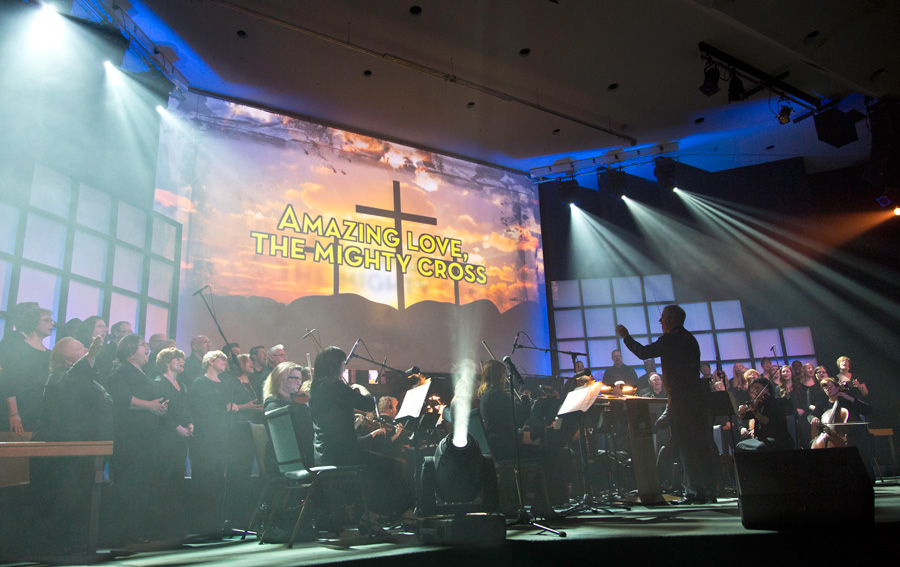
Photographing soloists is perhaps the most challenging as they are virtually always in a bright spotlight against a much darker back ground. This creates big problems for the camera metering system which ‘sees’ the primarily dark scene and tends to ignore the small real-estate occupied by the brightly lit person in the frame. The result is an overexposed person with blown highlights and a result that is destined for the round file. To correct this problem you need to underexpose the meter reading by two to four stops depending on the situation. All of the soloists shown here were underexposed three stops with the exception of the first which was four (the less area in the frame occupied by the light, the greater the compensation required to preserve the highlights). The pleasant result of underexposing to preserve highlights is the creation of even darker back grounds which makes for an uncluttered dramatic image.
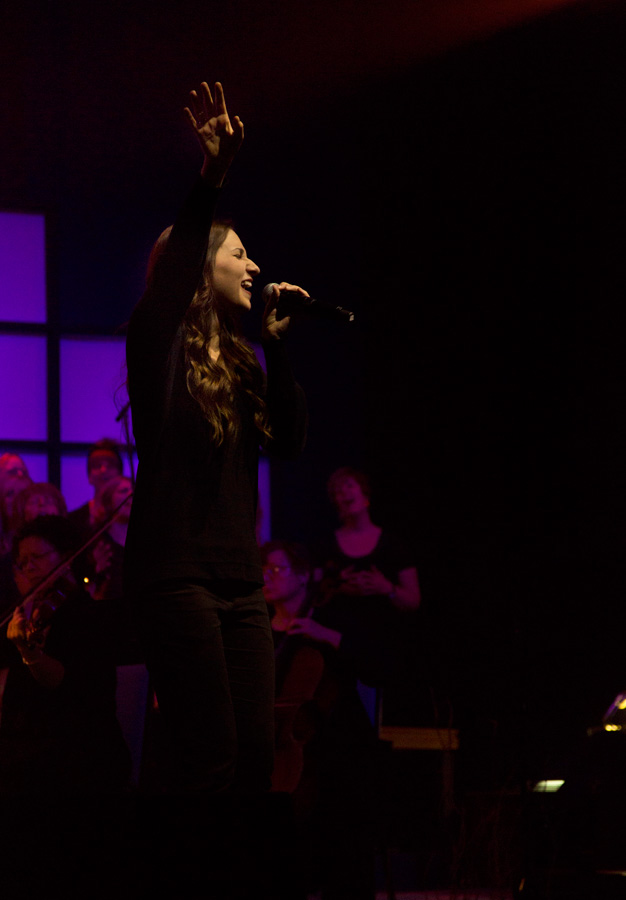
.
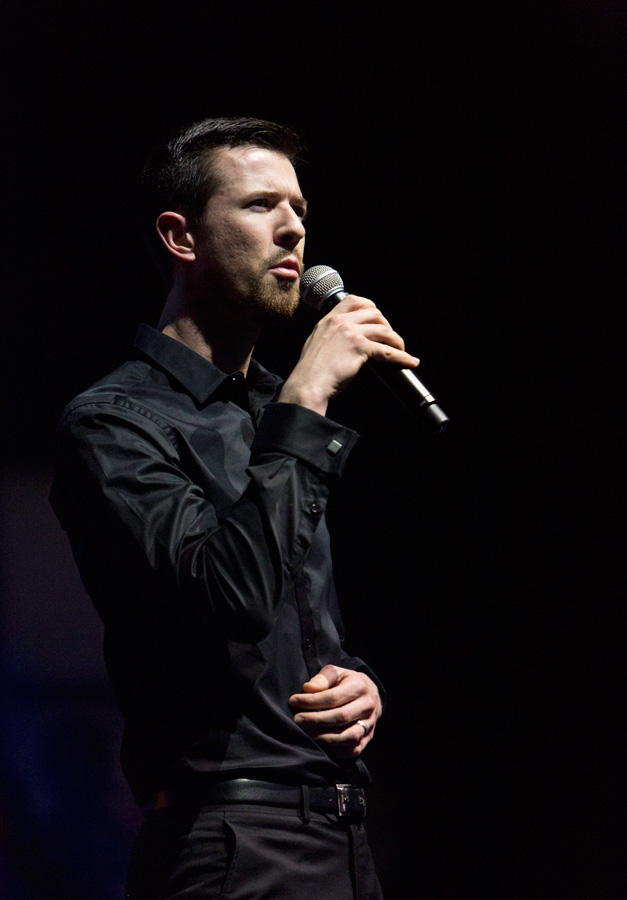
.
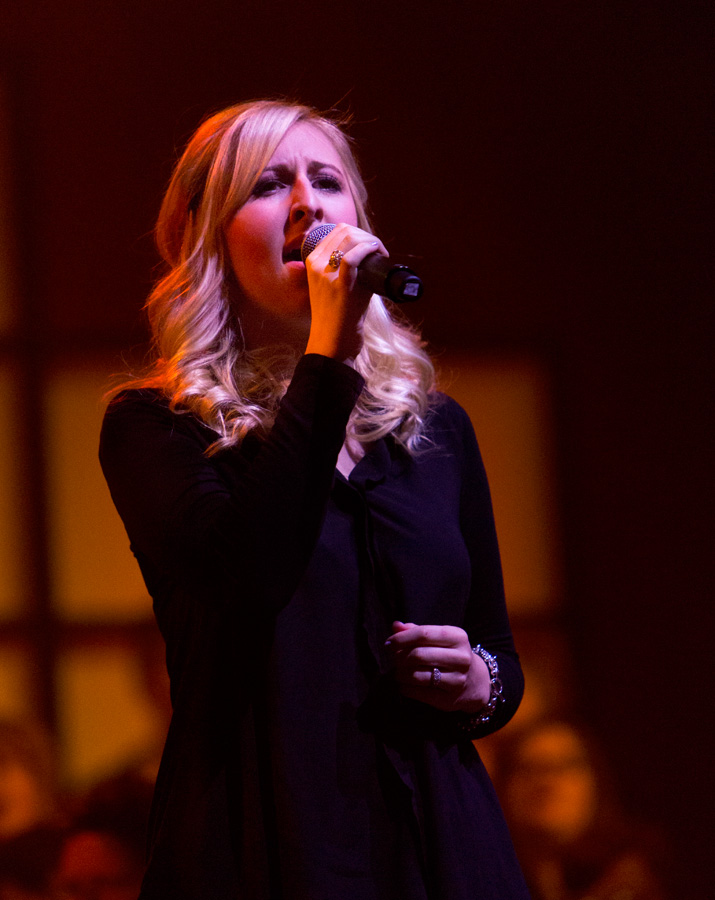
Always be ready to take a good exposure very quickly. The red back lighting in this next shot only lasted for a few seconds but provided an interesting dynamic to the image.
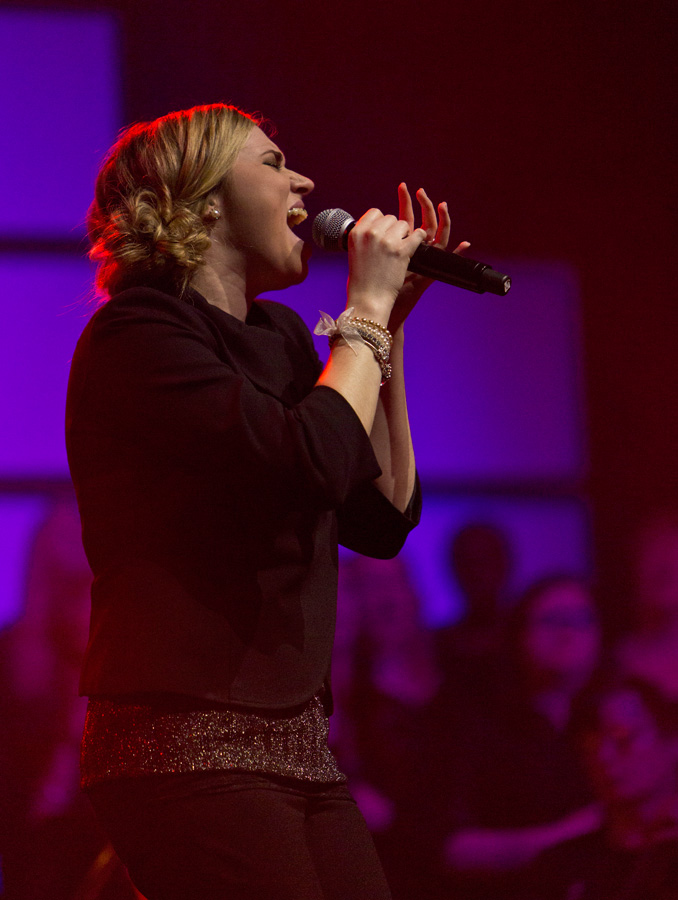
.
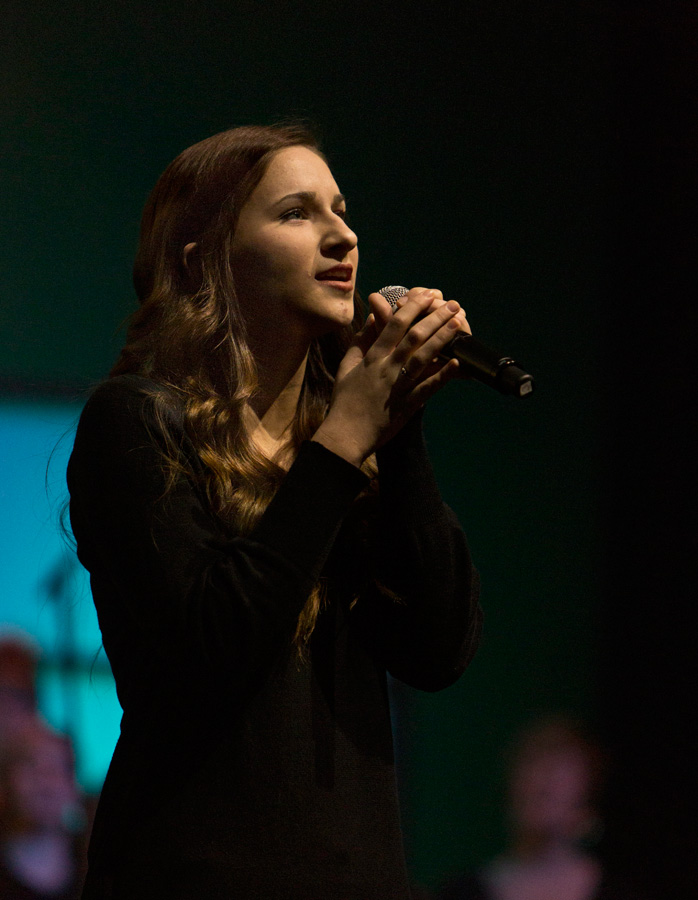
.

Most serious DSLR users shoot in RAW format (as opposed to JPEG) and for event photography using RAW is essential because of the great latitude it provides in post processing. RAW files are like digital negatives and contain all the data captured by the sensor at the time of the exposure, which although creating large files, allows for manipulation of that data in post processing, including exposure and white balance. When you shoot in JPEG format, in order to make smaller files, the camera strips out a lot of ‘non-essential’ data before writing the image to the memory card in the camera. Obviously the data removed is not available for modification in post processing and unfortunately exposure and white balance are two of the many things removed when you shoot JPEG’s. The variable and dynamic lighting conditions inherent with event photography demands you take advantage of the insurance provided by shooting in RAW.
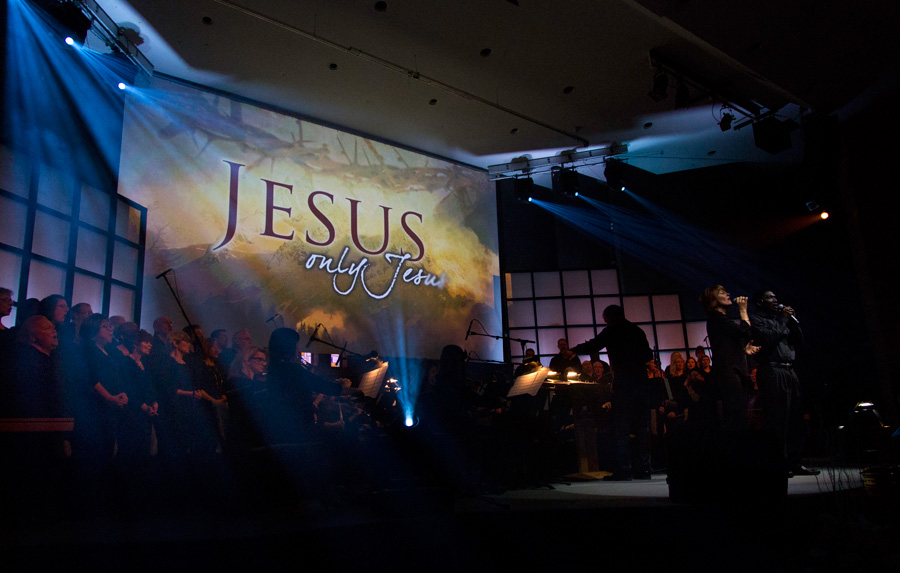
The rest of the images from the Easter presentation can be seen by clicking this link to the CBC – Easter 2014 gallery.
I trust you have enjoyed a wonderful Easter weekend and thanks for taking the time to go through this post. As always, your questions and comments are much appreciated.





































































































Follow Scott Martin Photography